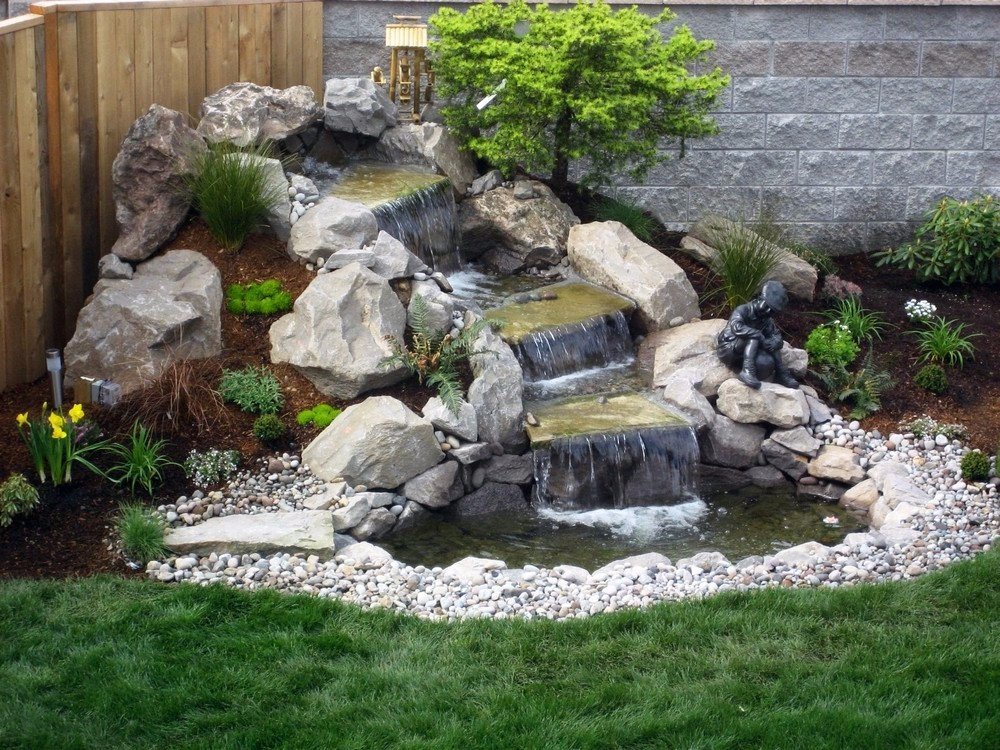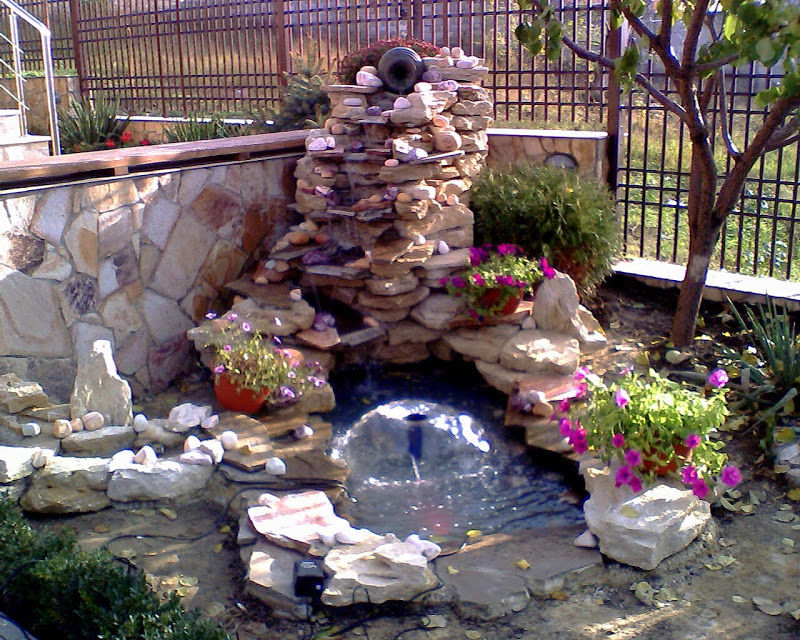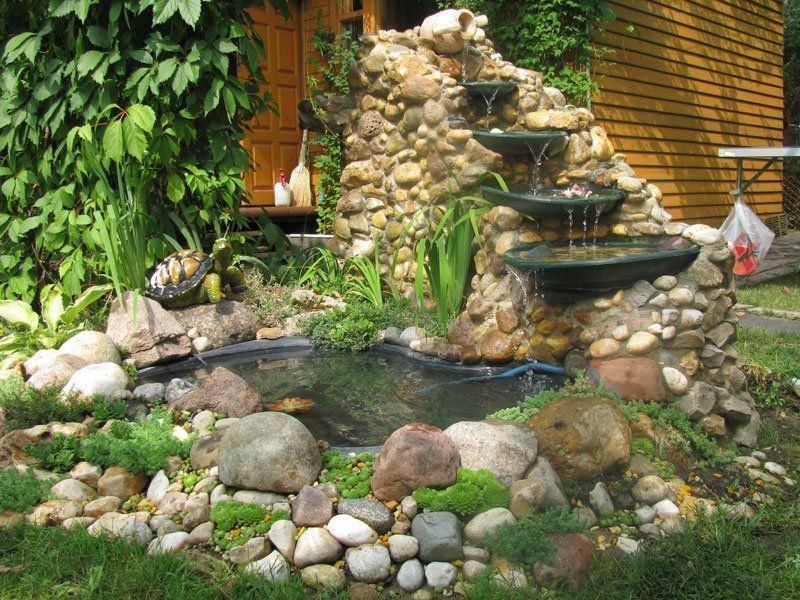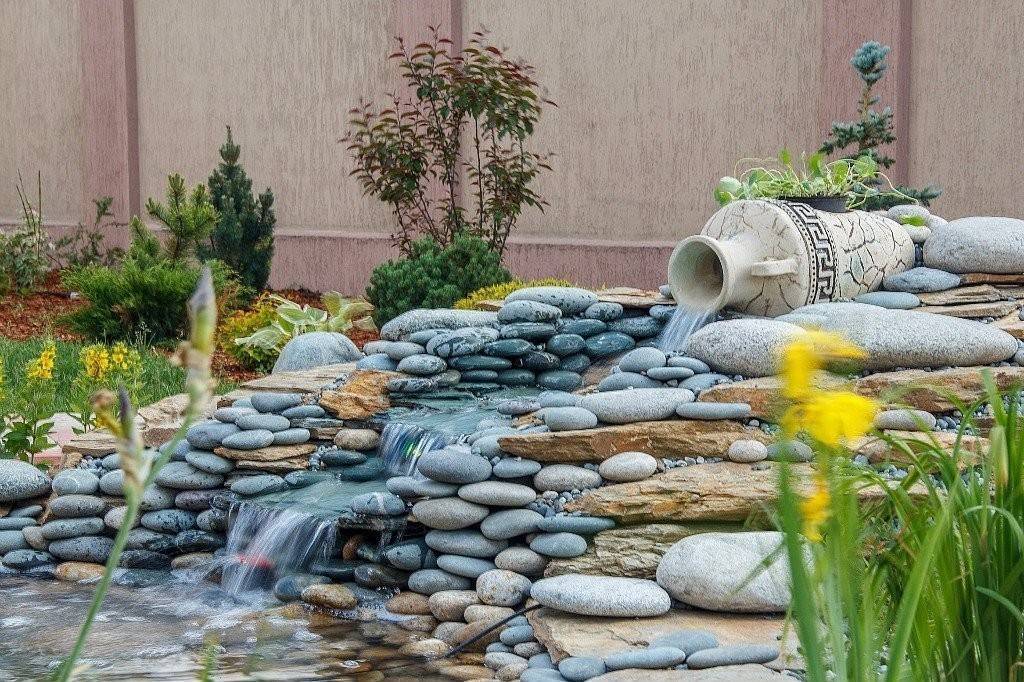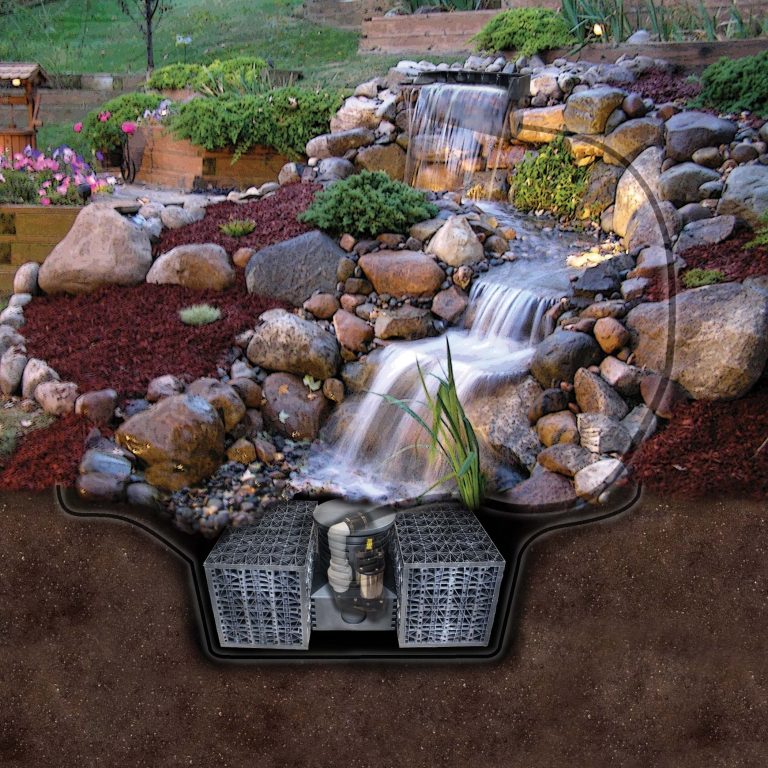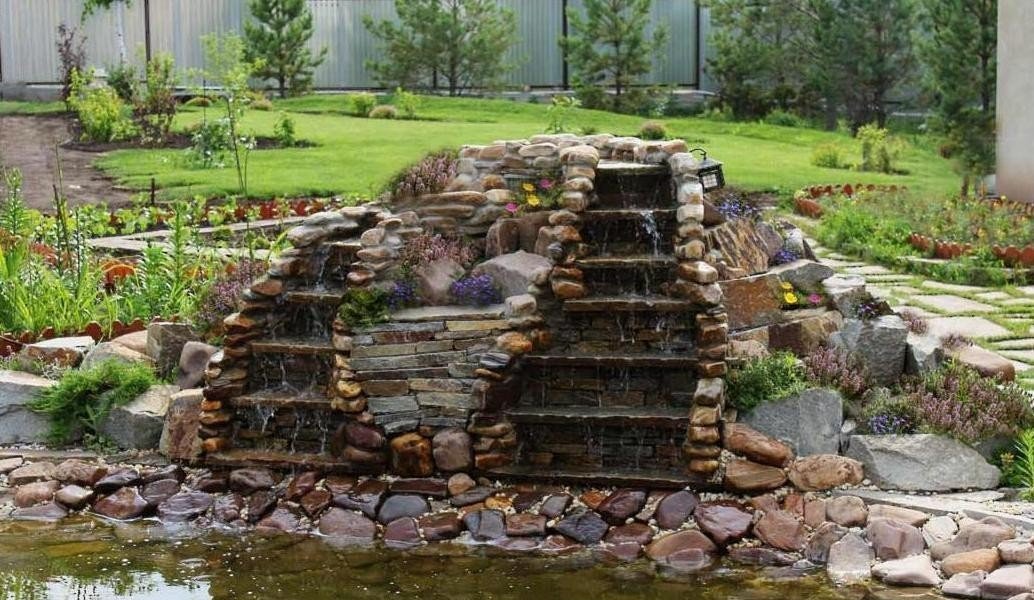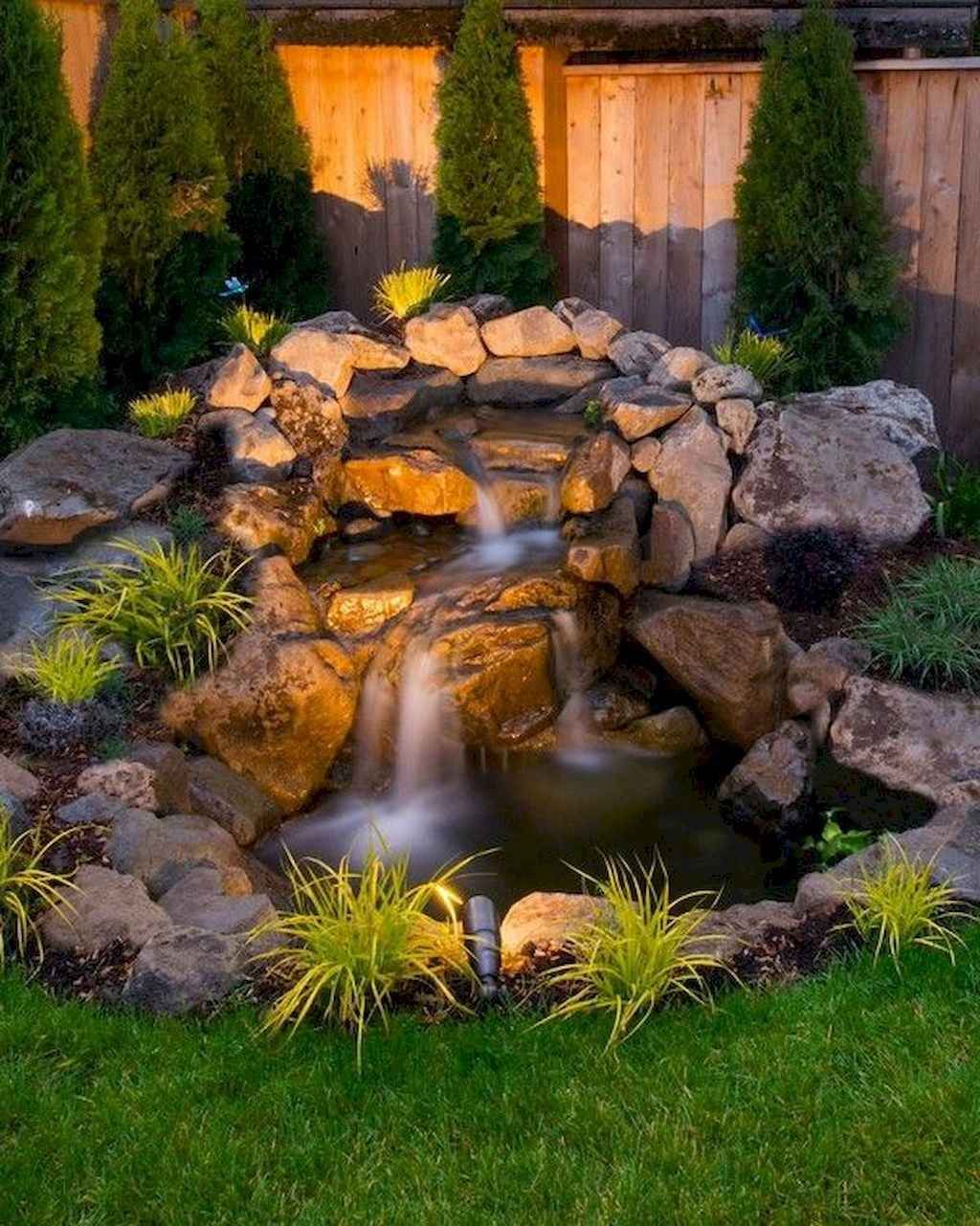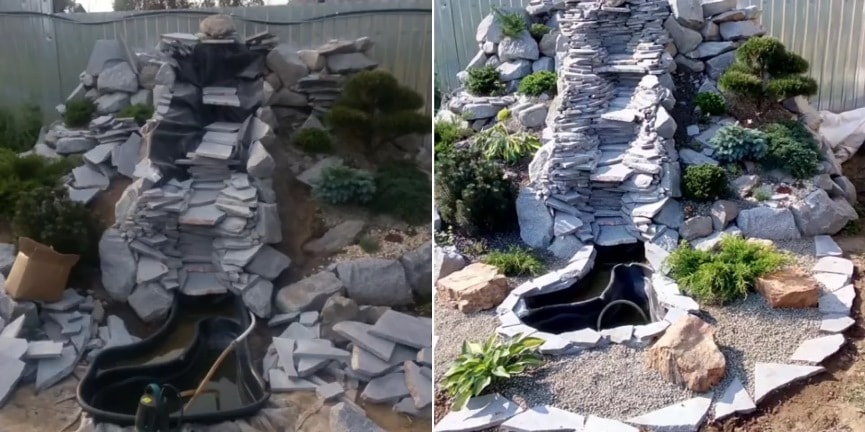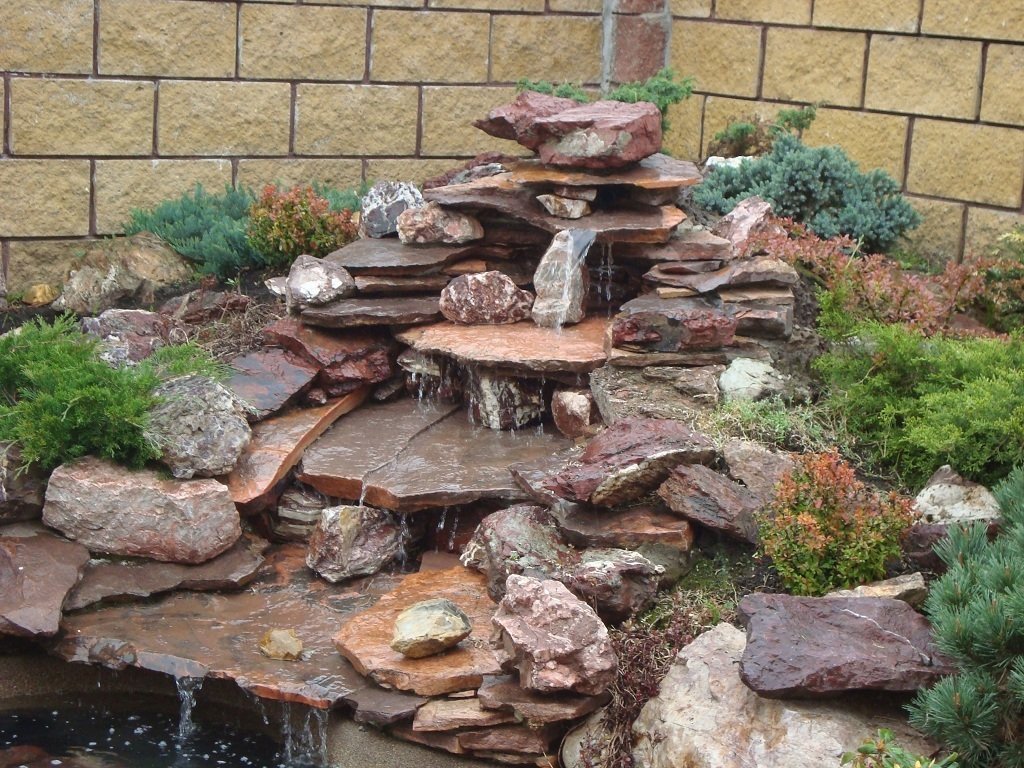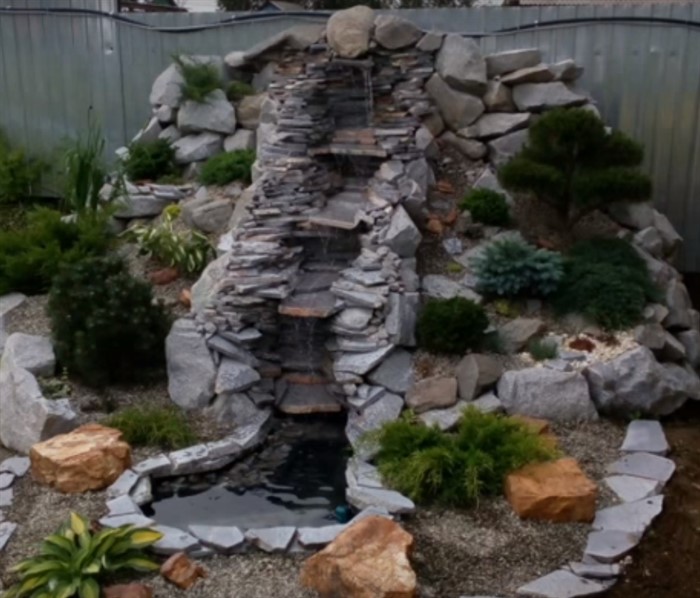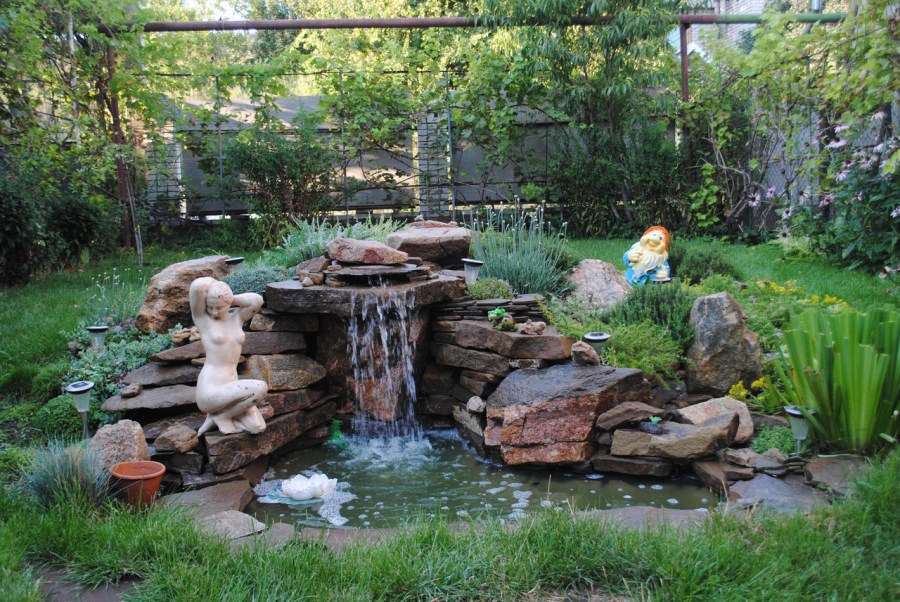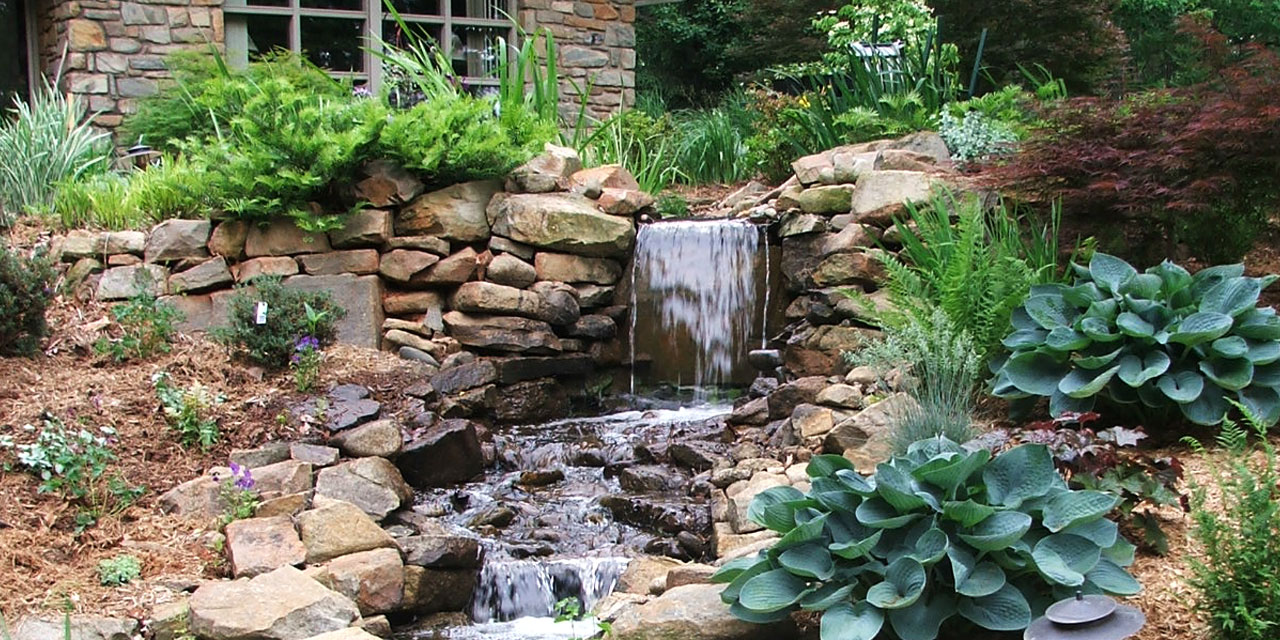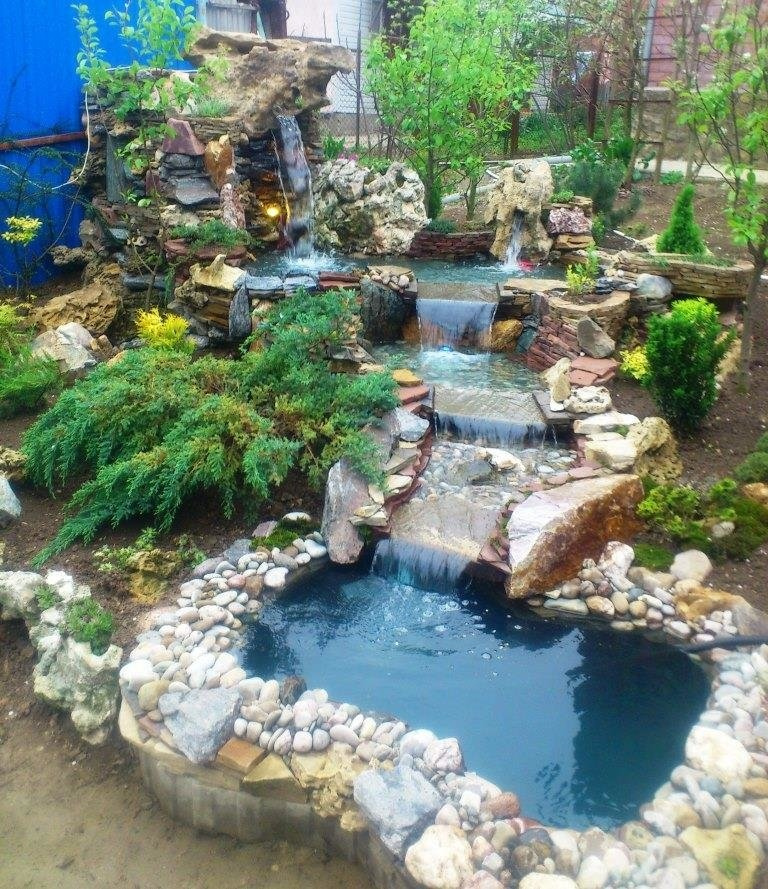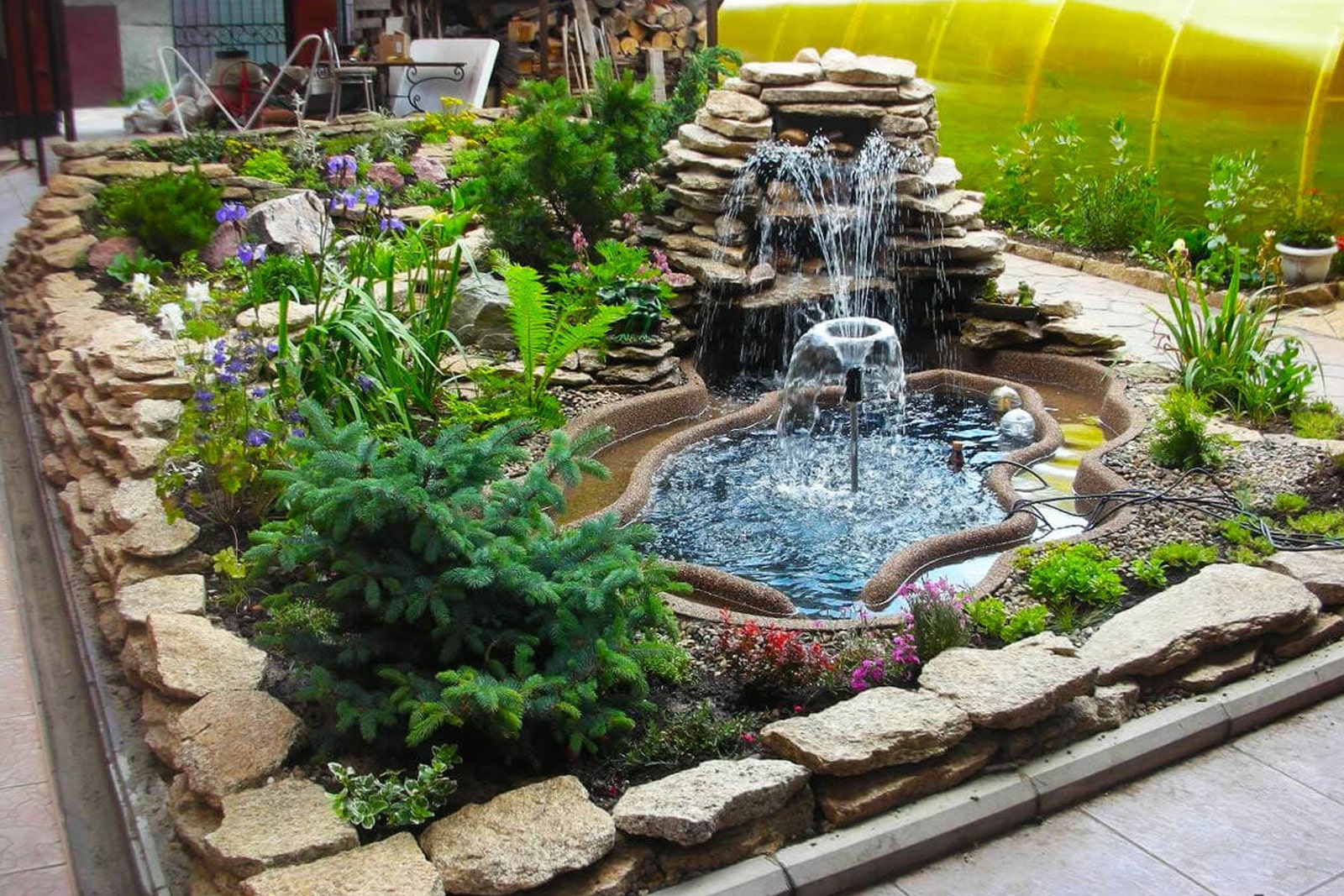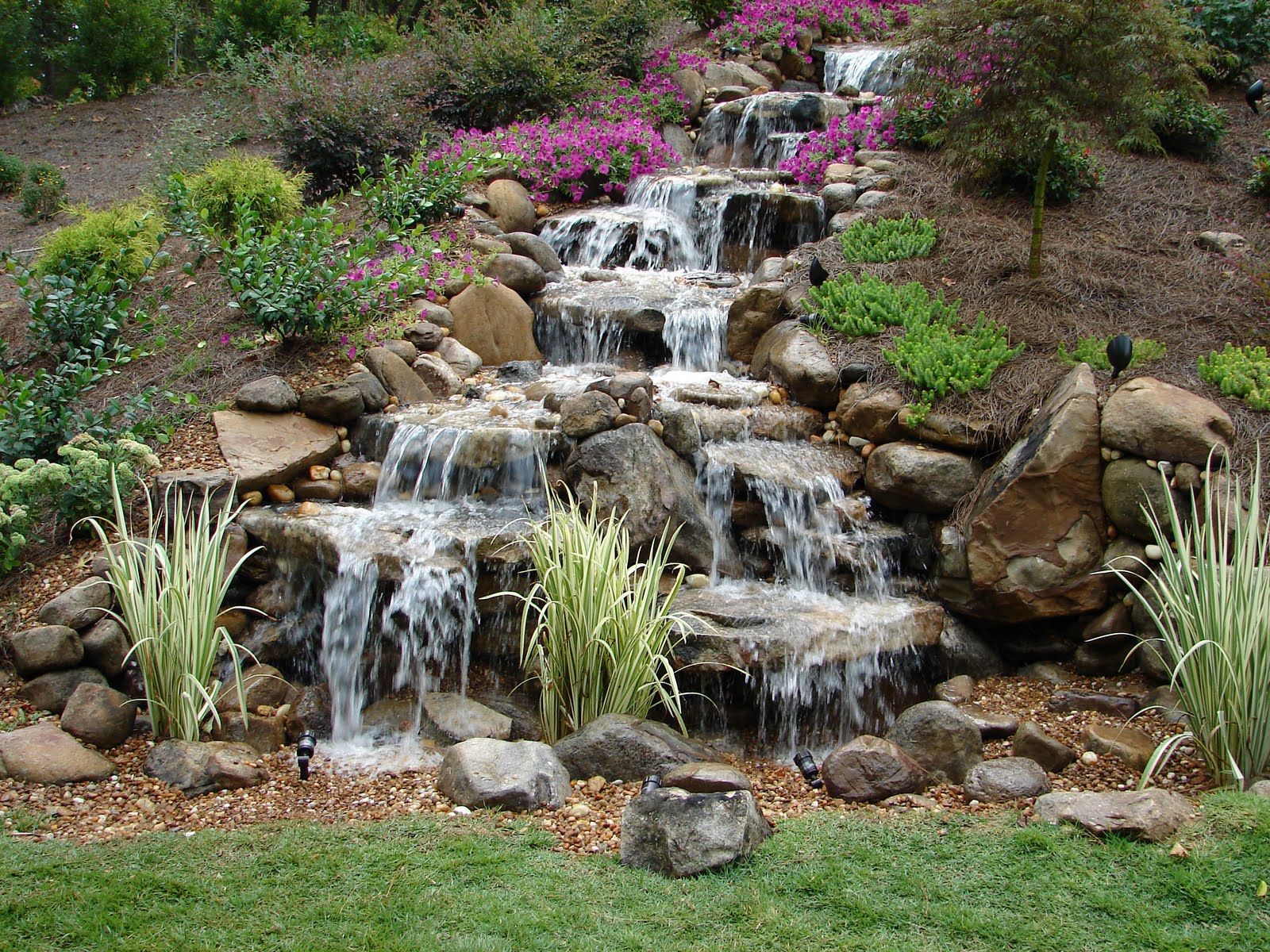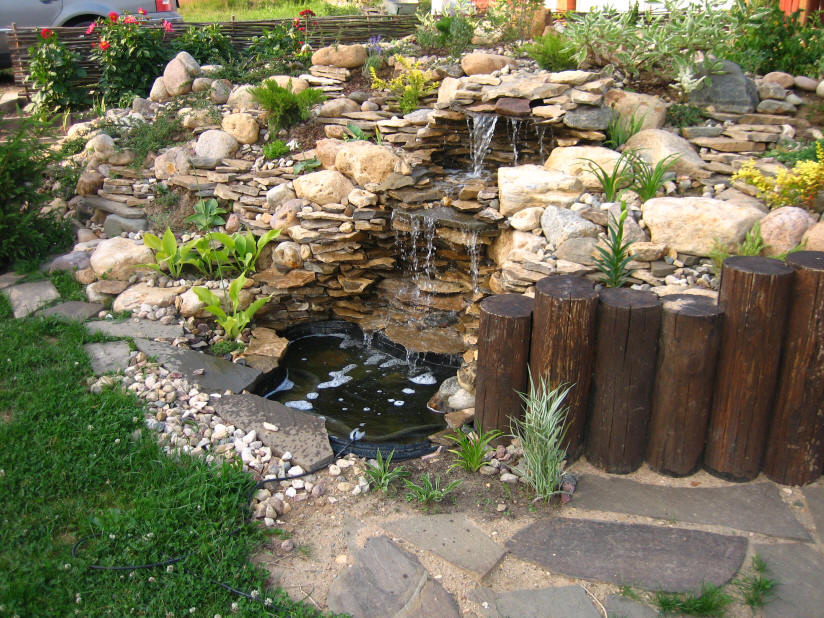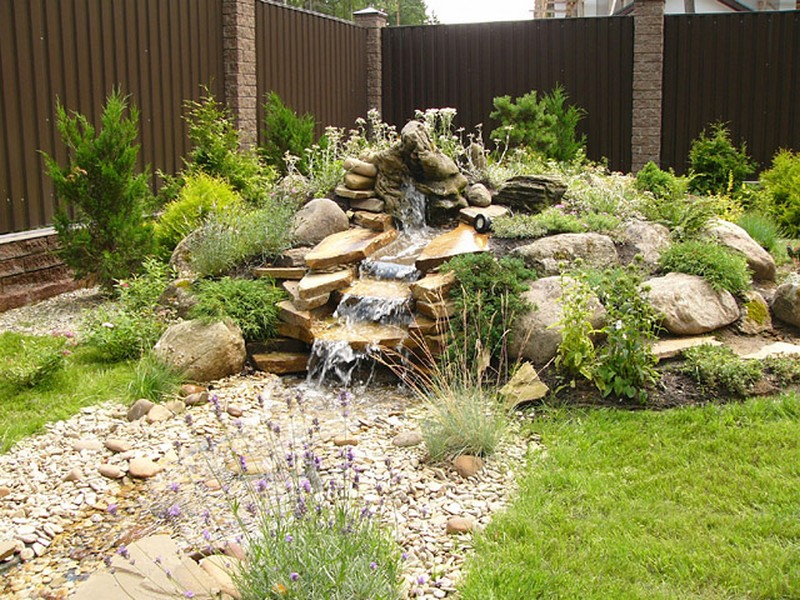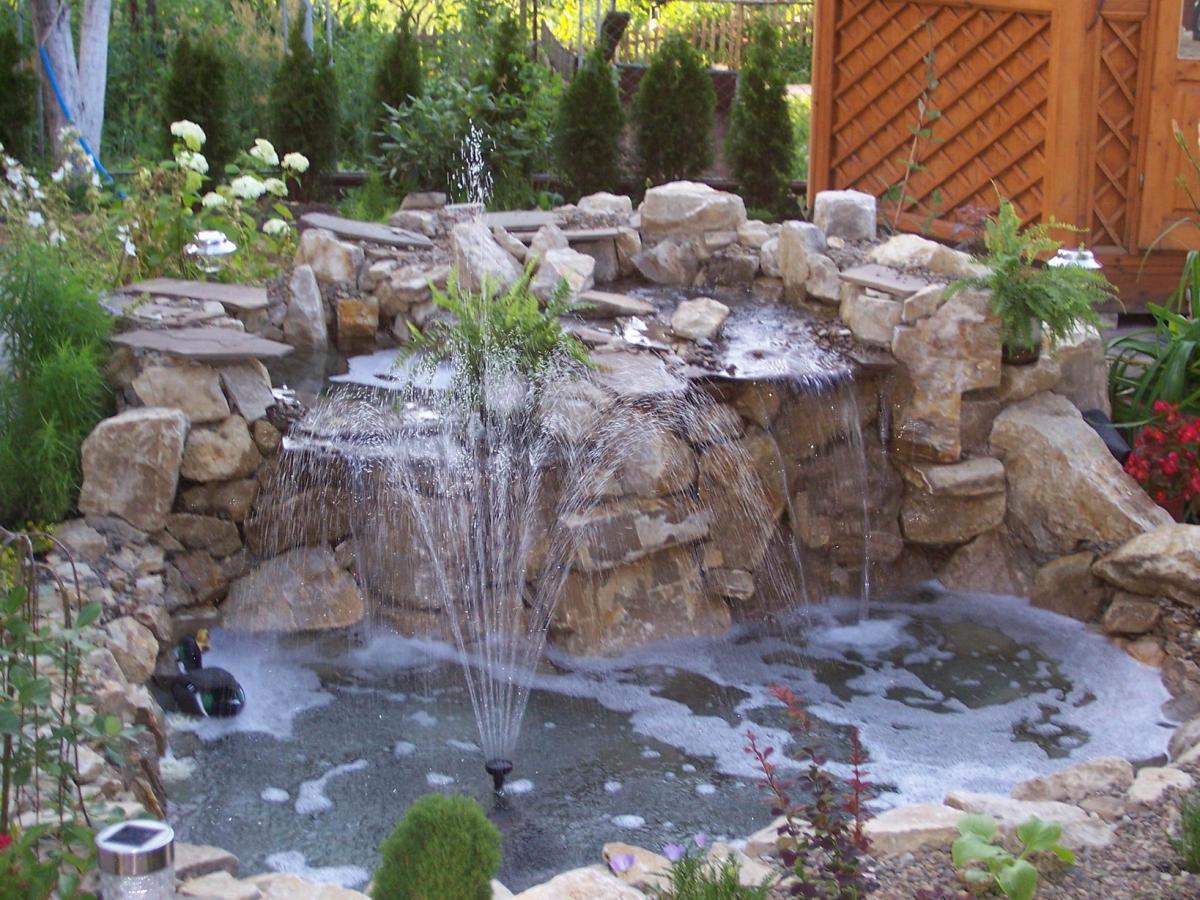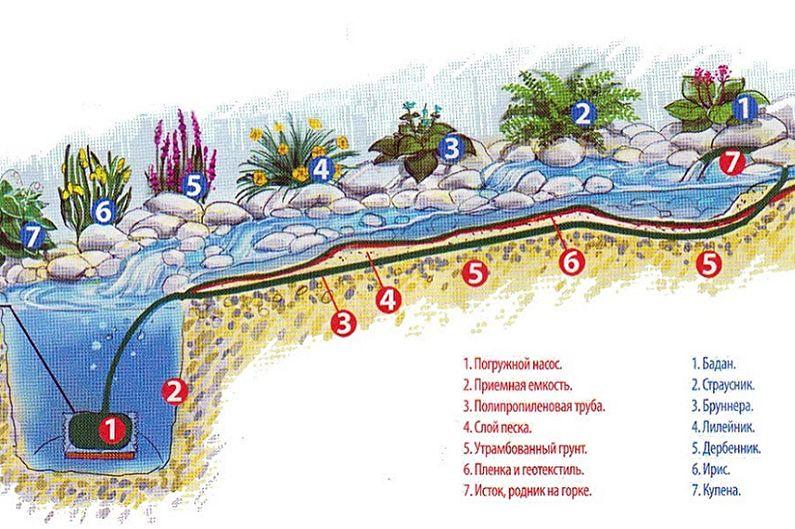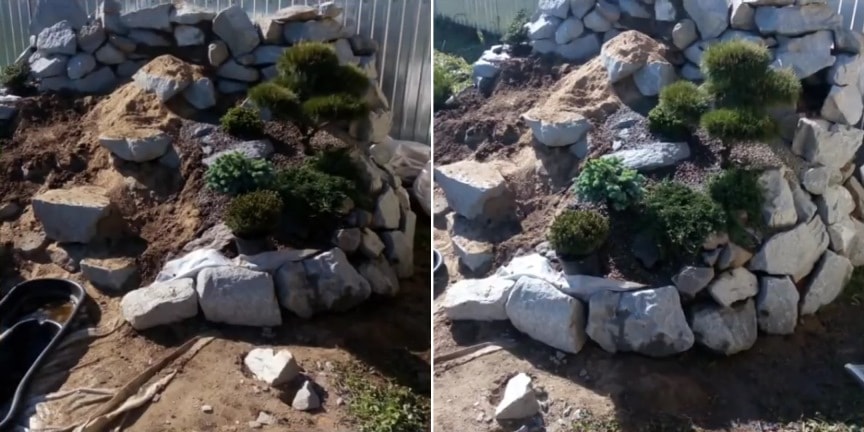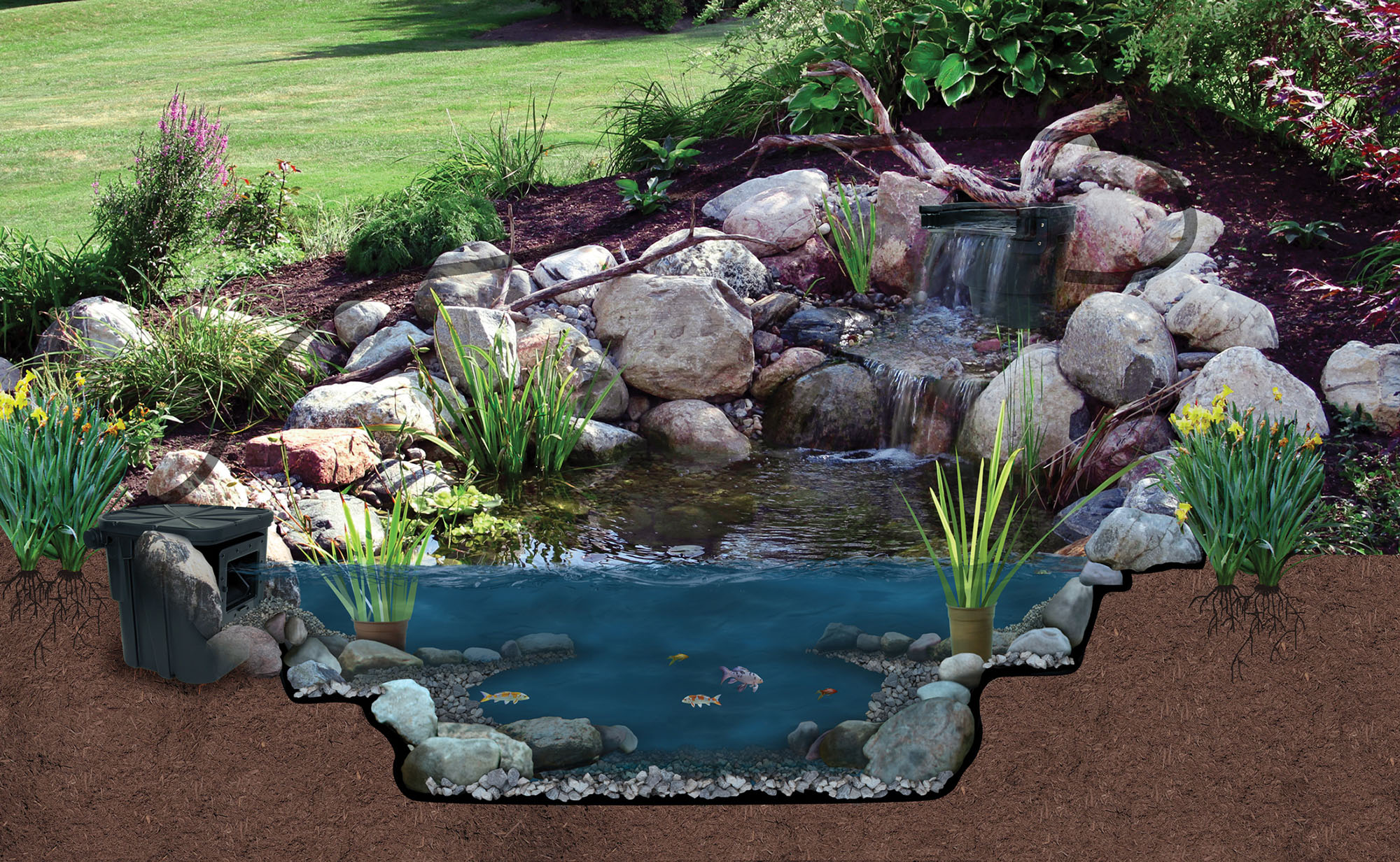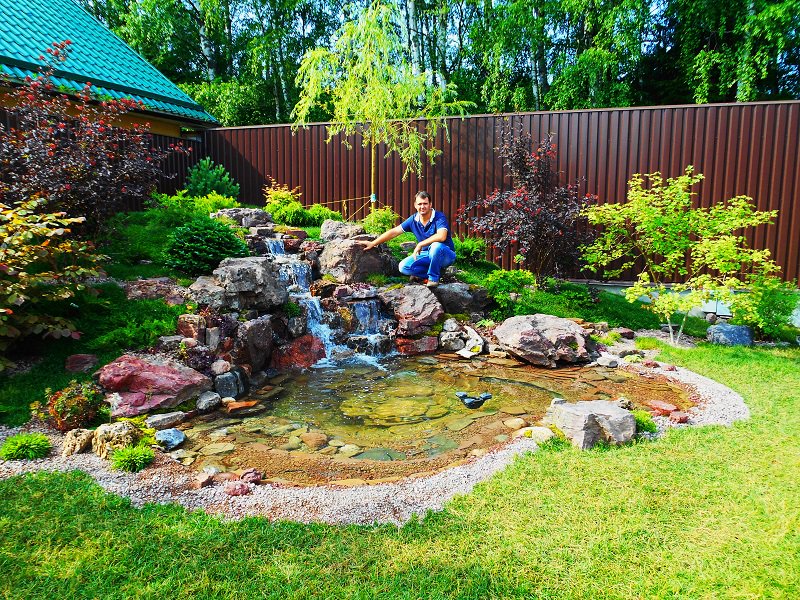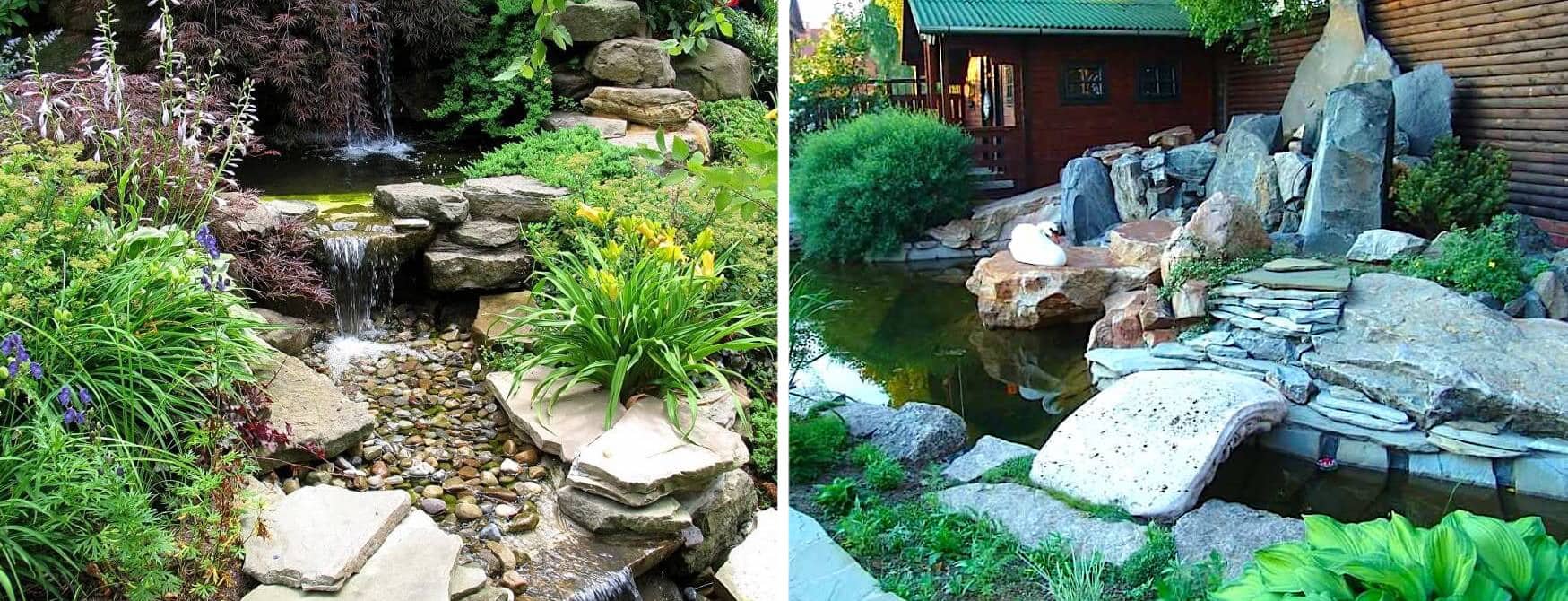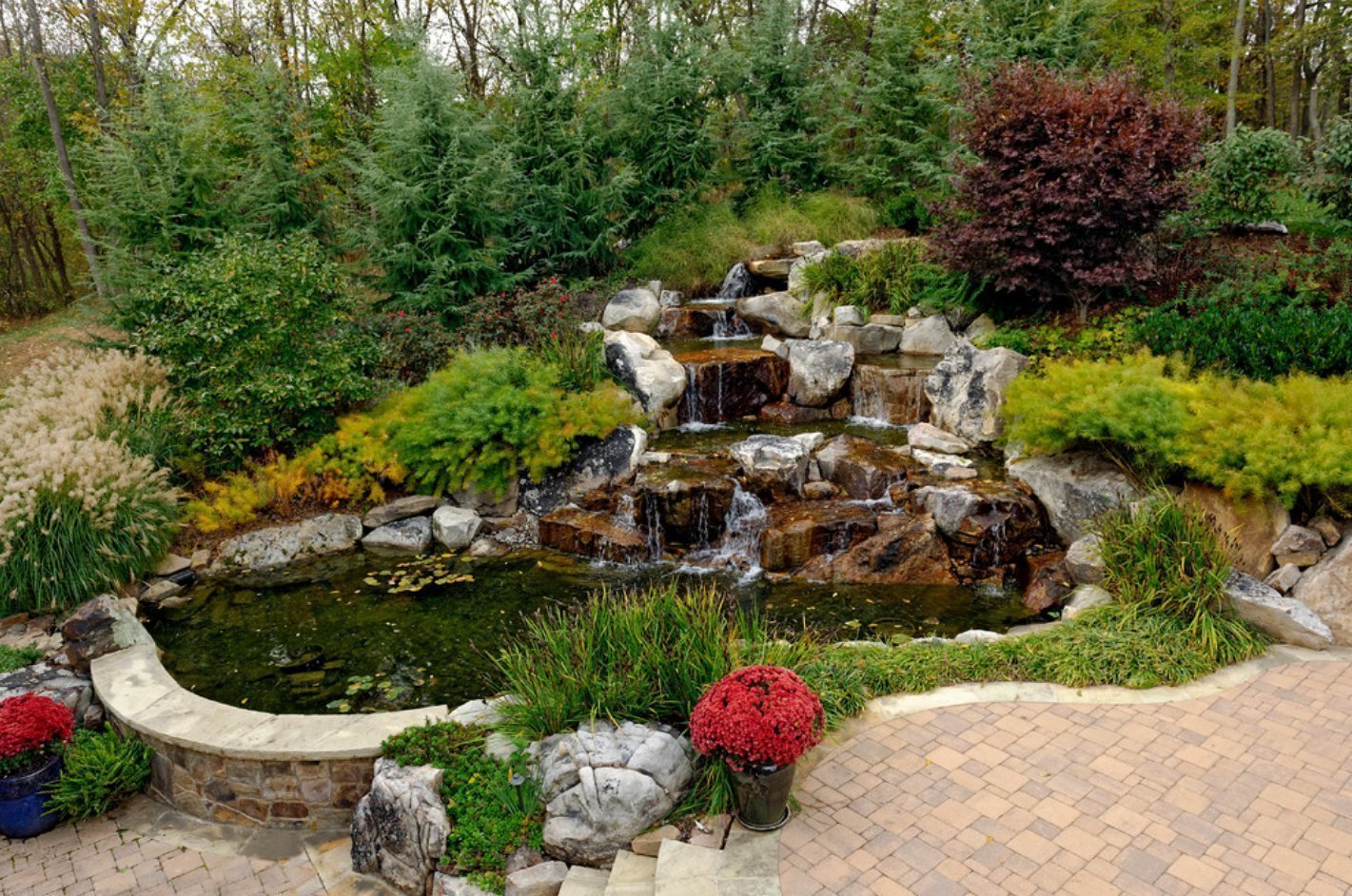Choosing stones for an alpine slide
There are many varieties of stones that will look great in your garden. These include:
- granite;
- wild stone;
- limestone;
- tuff;
- sandstone and others.
 Planting of perennial plants.
Planting of perennial plants.
Observing the following simple rules, it is easy to create an alpine slide with your own hands. Step-by-step photo placement of stones will help you choose the optimal design for any area. So:
- the selected stones should not be of the same size;
- it is preferable to select specimens uneven in shape and structure;
- the finished flower bed should be asymmetrical to the maximum;
- the selected stones must be of the same type.
 Planting conifers.
Planting conifers.
You can arrange stone elements in different ways, it all depends on the owner's imagination. Professional designers offer several schemes for laying boulders. Large stone blocks located throughout the entire area of the rock garden, with smaller fragments scattered between them, look quite original.
Someone will prefer to place the most beautiful and interesting boulder at the very top of the slide, while someone, on the contrary, will lay large specimens closer to the bottom. Any options are eligible for implementation.
When creating a rock garden from a massive stone, try to seek help from family and friends. It is quite difficult for one to master such a structure with his own hands. A photo of alpine slides with stones demonstrates the scale of these compositions.
 Backfilling of small stones, the final formation of the composition.
Backfilling of small stones, the final formation of the composition.
When installing large and medium stones, you should take care of their stability. In places invisible to the eye, they can be fixed with cement mortar to give the whole structure greater strength. Slightly dug boulders look good. This move allows you to simulate the rupture of the soil by rocky rocks and strengthen the entire rock garden.
On a note! An alpine meadow looks good on a garden plot. It is a bright green meadow covered with meadow flowers. For its device, stones are usually not used, but the effect of a slide is created by placing the plants in height.
 Watering the finished rock garden.
Watering the finished rock garden.
After arranging the base, after a couple of months, you can start planting plants. You can use any types of plants that do not require particularly careful care, tolerate bright sun and heavy rainfall.
On a note! In order for a rock garden to delight you with beauty for a whole year, you need to know the timing of flowering of various plants. Bulbous ones bloom in spring, in autumn mostly perennial specimens, and in winter they do not allow an alpine hill to be empty - conifers.
It is better to select slow-growing specimens for arranging an alpine slide in the country with your own hands. Photo-finished compositions show how original and beautiful, for example, coniferous evergreens on such unusual flower beds can look.
Looks good:
- thuja;
- some types of firs;
- juniper;
- mountain pine.
Such plants can be given any intricate shape. With their original appearance, they ideally complement an alpine flower garden. Gardeners give such fauna representatives a conical shape or cut them in the form of other interesting figures when creating an alpine slide with their own hands. Step-by-step photos showing the correct cropping options will help you cope with this task on your own, without inviting a landscape master.
Of herbaceous plants, the following are suitable:
- periwinkle;
- undersized carnation;
- thyme;
- nasturtium;
- marigold;
- bell and many others.
Form and types of cascades
The forms and types of waterfall cascades in the country can be completely different.The simplest options can be made from materials at hand. Lovers of grandiose structures will love the multistage large structures with fountains, streams and canals.
The choice of the type of cascade depends on your capabilities and strength. Calculate in advance how much space you can allocate for the composition, how much money you are willing to spend.
The location of the waterfall can be completely different. How the water will drain depends on the stone from which it will pour. Smooth flowing streams are obtained from stones with rounded, sanded edges. Glittering threads of water will flow from the cut stone. With the help of two stones and two levels of water drainage, an asymmetric flow will be obtained. In this case, the volume of water in both streams can be the same. If the volume of water is limited, it is best to have it flow around the stone.
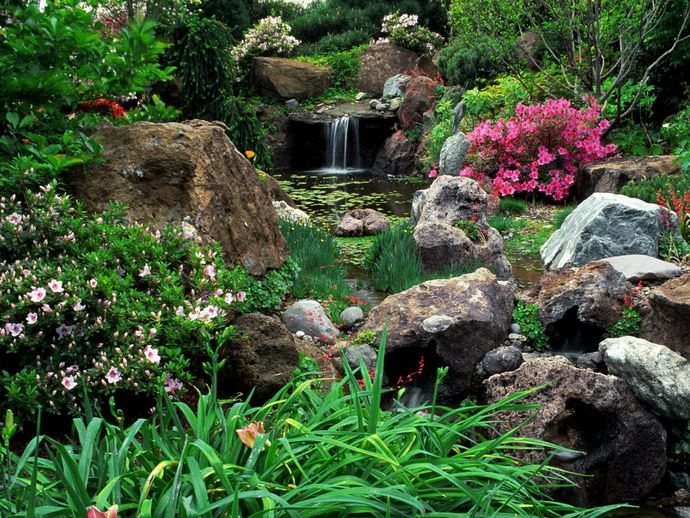
How to choose plants for an alpine slide
The choice of plants for a rock garden must be thought out in advance, since each type of landscape is suitable for one or another set of representatives of the fauna world, for example, creeping species are inherent in rock gardens-slopes, and flowering types are inherent in valleys. Experts advise to select representatives of the flora that bloom at different periods so that the alpine slide can please the eye for a long time. Perennials, in most cases, bloom in the fall. This can be lavender, geranium, saxifrage, etc. Careful monitoring is required for their growth, since highly overgrown crops can block the sunlight from lower plants. Bulbous (crocuses, hyacinths) bloom in spring, and in winter conifers will not let the landscape empty - thuja, some varieties of spruce, etc.
On the alpine slides, there are also low-growing shrubs such as Japanese maple, rosemary, azalea, dwarf roses. From herbaceous representatives, you can choose thyme, bells, marigolds, and edelweiss, phlox, and dwarf ferns are also often planted on slides. Ground cover daisies, St. John's wort, and yarrow will perfectly cover the empty spaces between the stones.
When planting, one of the important rules must be taken into account: undersized species are planted in groups, and lush flowering species are planted separately. Planting plants in the ground begins from the top of the alpine slide and gradually moves to its foot
To avoid water evaporation and block weed infestation of plants, you need to leave a small funnel around each specimen during planting, into which pebbles are poured.
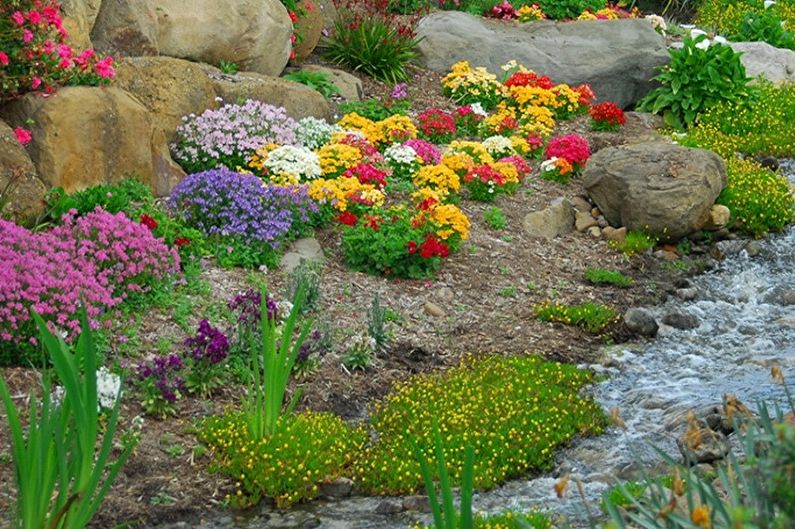
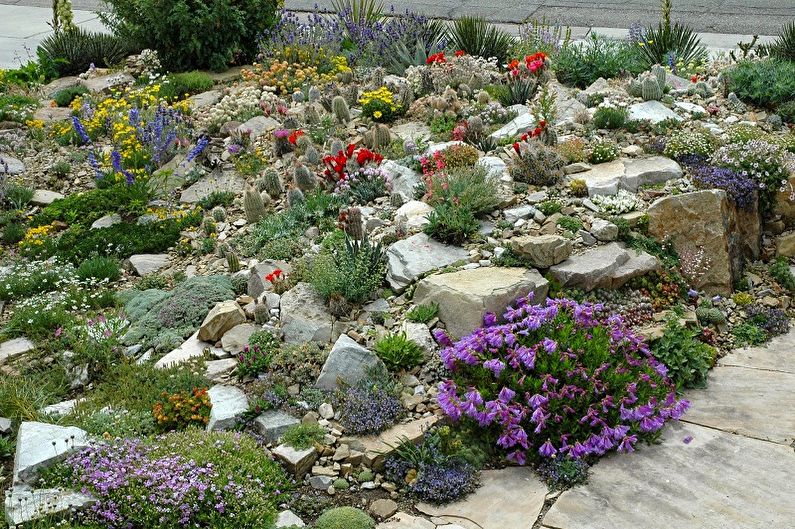
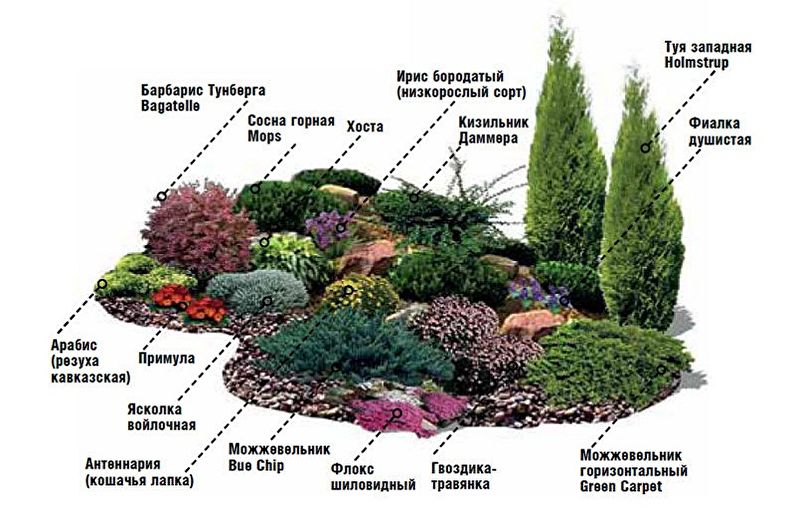
How to make an alpine slide in a small area?
If you have firmly decided that a self-made alpine slide will become a decoration of your garden - step-by-step instructions will give you the opportunity to avoid gross mistakes and get the desired result.
Before starting work, sketch out a sketch of a rock garden - this will help you decide how much area it will occupy, what configuration it will have and how many tiers you will make on it.
You can even roughly estimate how much an alpine slide will cost you - a scaled diagram will help you calculate how many and what stones you need, how much drainage, sand and soil you will need to prepare. You need to make a scheme in relation to the terrain in order to use all the beneficial points of the existing landscape.

Creative decoration of rock gardens - clay bowl with plants
When deciding on a place for the future rock garden, do not forget that you will need to look at it - choose the most favorable angles. Also, think - you might want to spend your free time with him. Then you will need an adjoining flat area with paths, a place for a table and a hearth.

The path from the rock garden leads directly to the recreation area
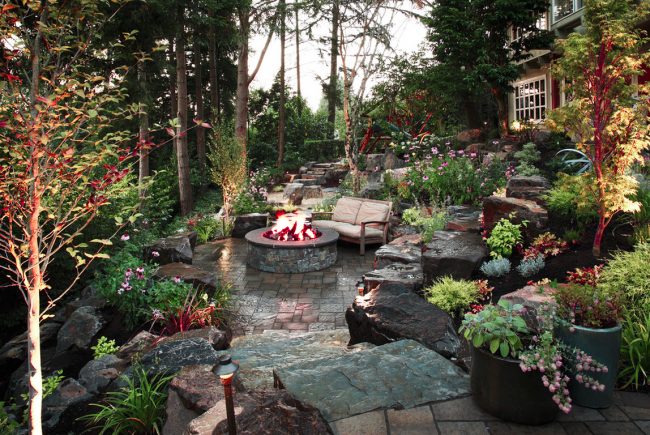
Cozy corner for relaxation in the "rock garden"
Very interesting visual effects will be obtained when using the natural unevenness of the relief - the decorative elements inscribed in the natural landscape will be a great addition to it.
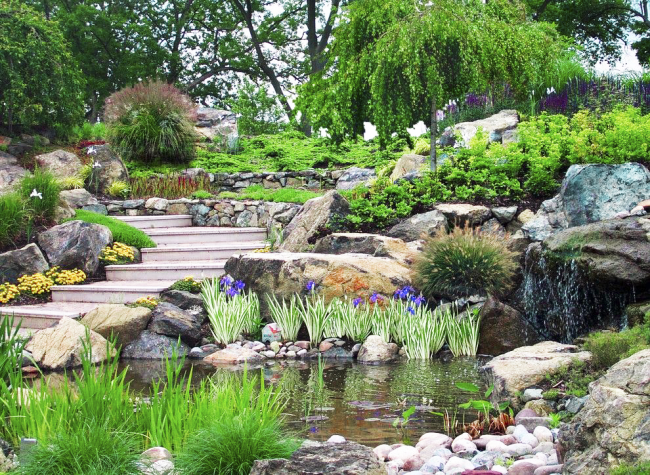
Spectacular alpine slide with a small pond
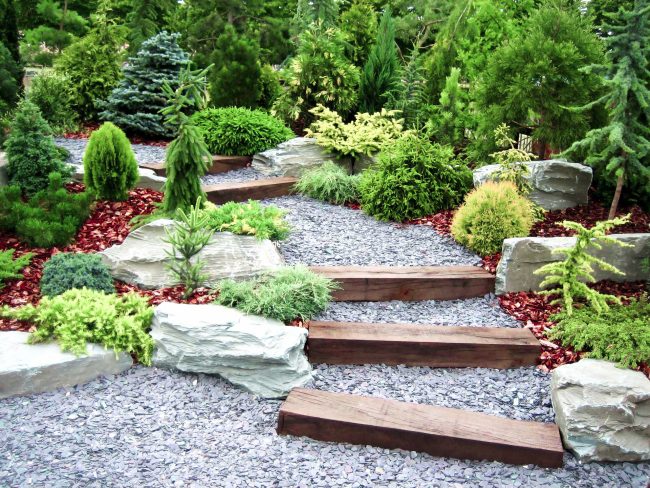
This is not an imitation of a landscape, but simply an artistic composition of asymmetrically located boulders with paths between them and plant compositions.
-
The next step is to transfer your schematic to the site. Make the markings with twine or sprinkling the necessary lines with contrasting material - sand, lime. This will allow you to look at the proposed location of the rock garden from the side. Perhaps you decide to slightly change its configuration in accordance with the relief.
-
Having approved the choice of location, you need to prepare the site for laying stones. Soil, mostly consisting of clay or black soil, will have to be drained; sandy soils do not need such preparation. For drainage, the earth is taken out to a depth of at least 30 cm, the pit is filled with building materials of large fractions, rammed and covered with removed soil flush with the surrounding ground. To compact the loosened soil, it is spilled with water.
-
The largest boulders are laid along the perimeter of the prepared site. If necessary, they can be buried in the soil - then they will have a more natural look. The internal space is filled with soil, which will become the basis for the next tier, as well as a habitat for plants.
-
Having retreated the calculated distance from the first row, put the next chain of stones, maintaining the desired configuration of the rock garden.
- Having completed the required number of tiers, they form the top. To do this, you can lay one large stone, or use several small, stacked pyramids. This will prevent the soil from being washed out and will also complement the composition.

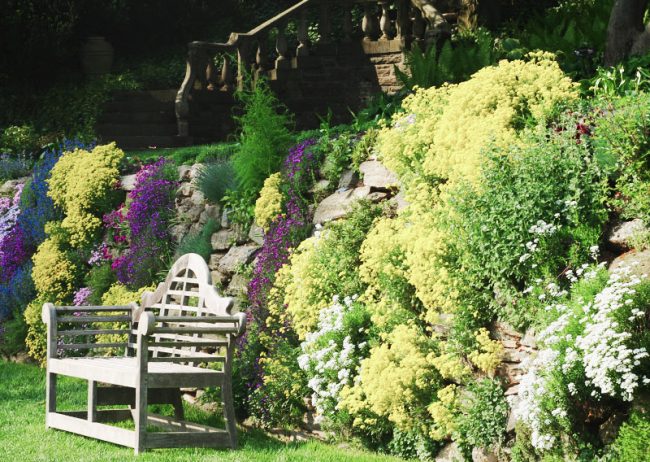
Vertical blooming alpine composition creates a romantic mood
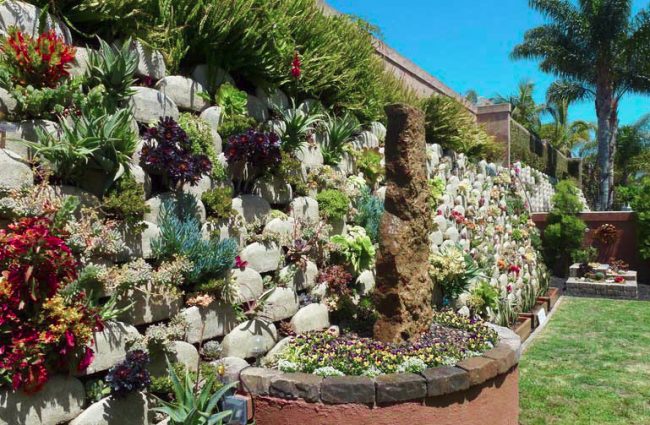
Retaining wall in the form of a rock garden - a new salvation from "boring" walls
What stones to use
Stones are the basis of an alpine slide. At first glance, it seems that everything is simple, but there are some peculiarities in terms of choosing the right material.
The following stones are ideal for the construction:
tuff (travertine);
granite;
sandstone;
limestone;
gneiss;
basalt.
But whatever stones from the above you decide to use, you need to remember the following recommendations:
- For the design, you need to choose stones of different sizes in order to imitate natural naturalness.
- Also desirable are materials that are heterogeneous in structure and shape.
- Place the stones securely so that they do not accidentally roll off.
- The stones can be quite heavy in weight, so when creating a structure, you need to call relatives or friends for help.
- Some landscape designers advise using the material of the same breed, as similar as possible to each other in color, thanks to this, natural naturalness can be achieved. But this is not necessary at all, you can be guided by your taste.
Many people often have a question about where to get the stones to decorate the composition. You can buy stones in specialized hardware stores, markets, and garden centers.
What stones should you choose for an alpine slide?
The stones and plants for the alpine slide are the core of its design, so their choice must be taken seriously.
First you need to decide on the size of the alpine slide and start from them. If the alpine slide is large, large boulders can be used, otherwise (if the slide is approximately 5m * 3m) small stones and flagstones are used.
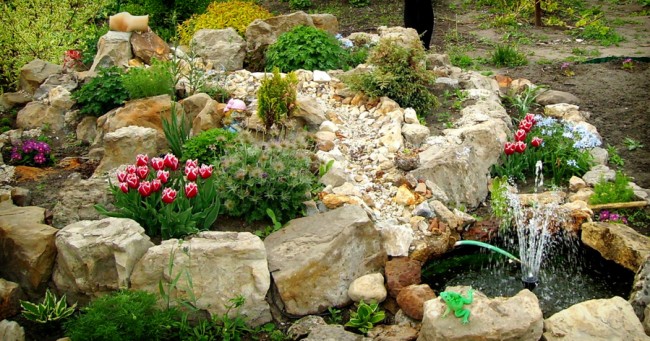
Stones for an alpine slide - the key to a spectacular design
When choosing stones, pay attention to their shape and appearance, because these criteria will be prominently displayed on the overall design of the slide
Stones should be laid in tiers, not less than 3, but not more than 5. Do not be afraid to experiment and embody the most vivid manifestations of imagination: create patterns from stones, make a stone composition, etc.
Remember that in winter and early spring, an alpine slide will not delight with flowering plants, so stones should create an attractive look even without additional decorative elements.
It is not necessary to make large distances between stones, because the created alpine slide may seem bald, but at the same time, do not forget to leave room for ornamental shrubs and flowers.
Avoid perfect symmetry in the placement of the stones, as the general view should resemble a piece of a natural site that has not been touched by a person's hand.
As for the arrangement of stones itself, it should be noted that the most massive boulders should be placed at the foot of the hill, and small stones should be placed closer to the top.
Among all the stones, choose the most attractive and original, in order to install it on the top of an alpine slide.
This, in fact, is all that I wanted to tell you about the constituent of the alpine slide - stones, now we turn to the next important element - the flora
Time to collect stones
Stones are of particular importance, which will serve as both a building and a decorative element for the slide.

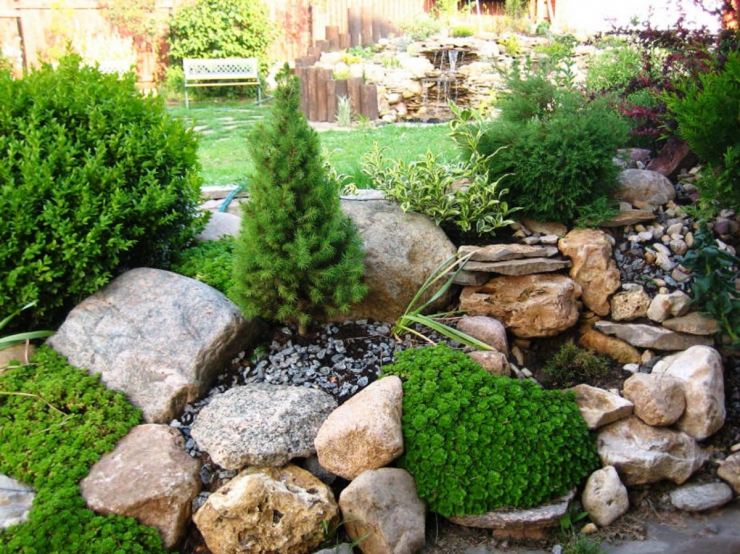
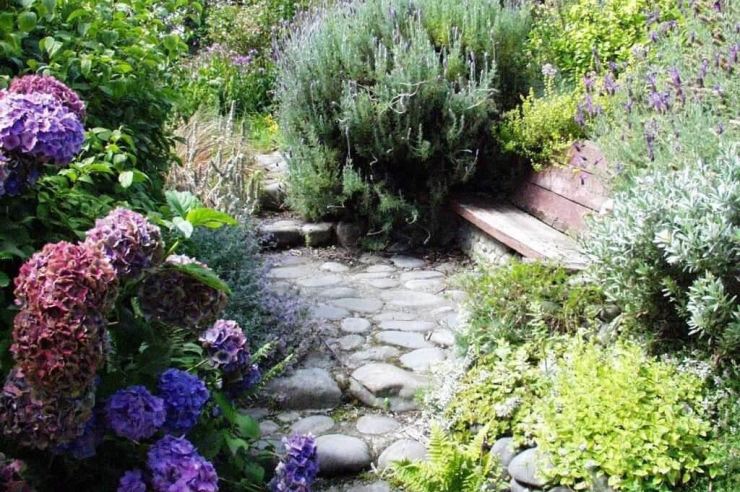
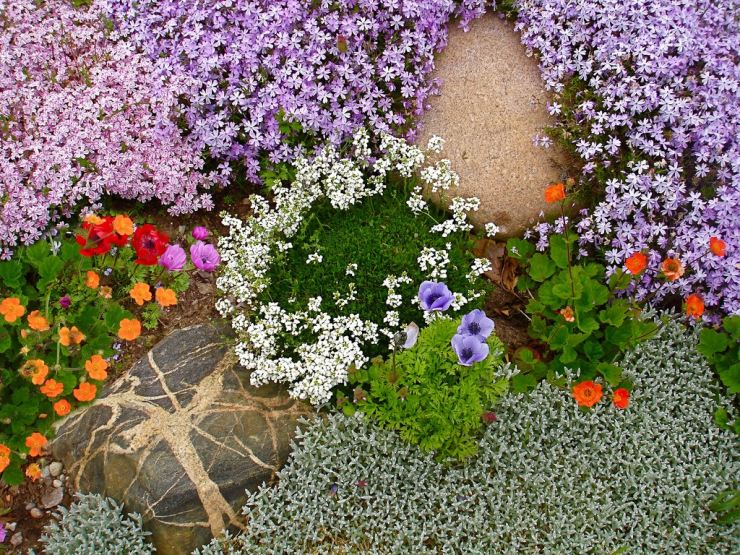
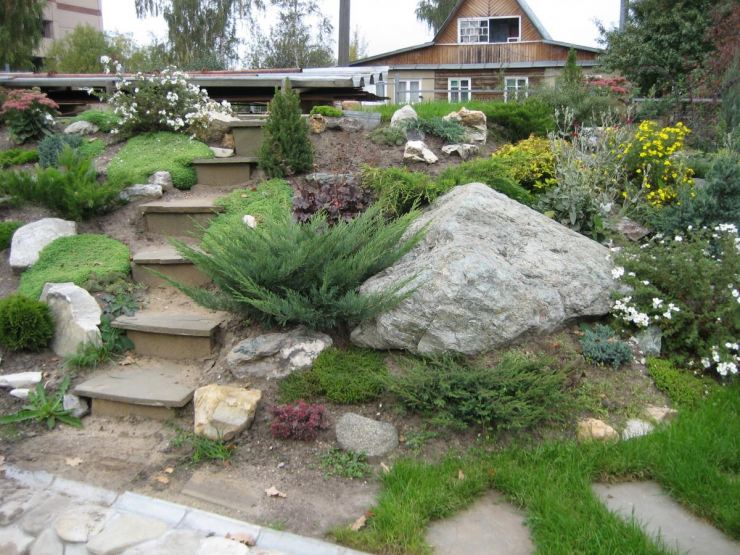

Their choice should be approached with special attention, and experts advise giving preference to rocks with a low porosity index.
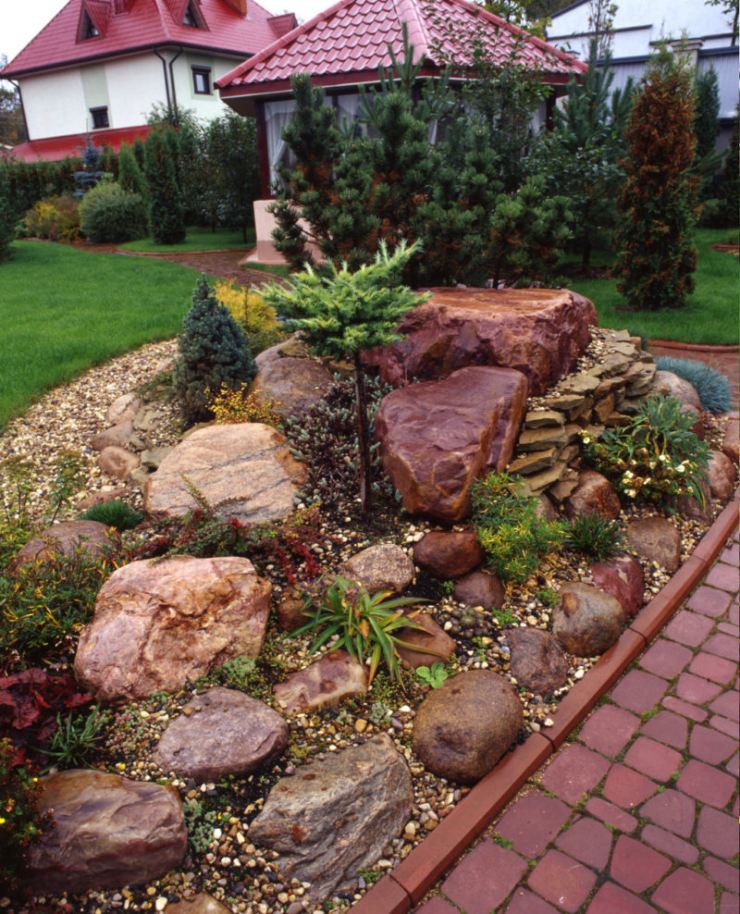
These include sandstone, granite or basalt. The same rocks, like tuff or shell rock, absorb water rather quickly, which leads to their relatively quick destruction.
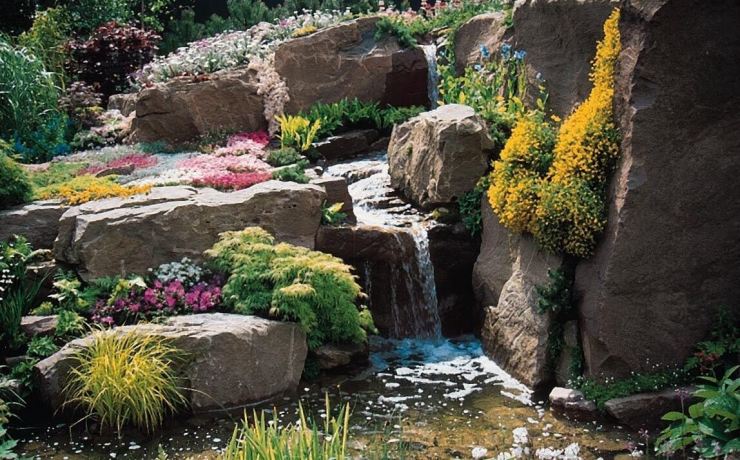
As for the shape of the stones selected for construction, it is better to look for a middle ground here.
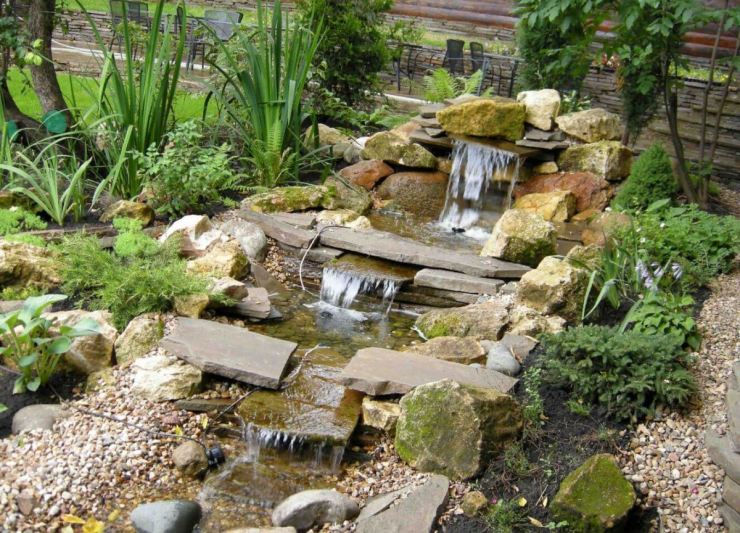
If you look at the photo of a do-it-yourself alpine slide, you will notice that the options look the most pleasant, in which the boulders are not too round, but at the same time they are not too angular and sharp. All stones must be of the same breed.
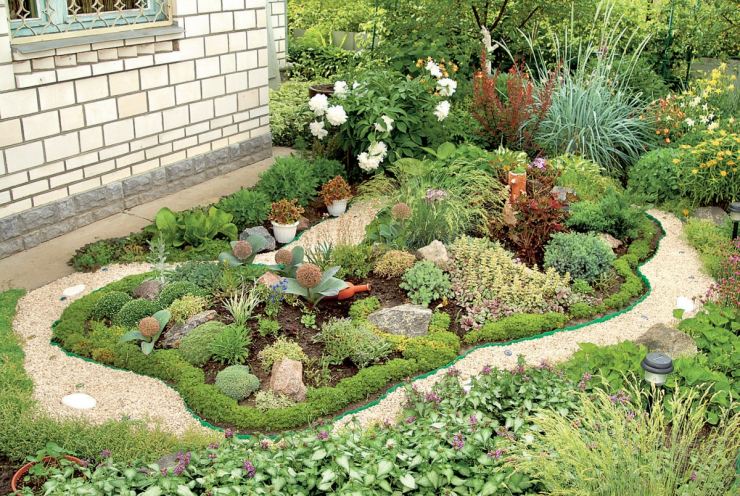
Slide construction
The construction of the slide is of no small importance. This construction can be done in different ways.
Stony slope
This option is characterized by a rocky shape, which is mainly made of stones. Plants are planted among them.
Terraced slope
This composition is characterized by protrusions at different heights. They are made using retaining walls. Buildings can have different configurations.

Mountain hollow
This area is characterized by stones of different sizes. They protrude from the ground. The boulders are supplemented with plants with a long flowering period.
Gorge
When constructing it, it is worth considering the terrain. Stones are used to decorate the slopes. At the same time, ground cover crops are planted on the hill.
Czech rolling pin
This is a multi-tiered hill that includes flat stones. They are folded vertically. Ornamental crops are planted nearby.
Valley in the mountains
The structure is made of large stones, which are partially immersed in the ground. The composition is complemented by lush blooming crops.
Choosing a place for the waterfall
Choosing a location for a waterfall is considered one of the most difficult stages in the construction of a waterfall. If the structure is positioned incorrectly, it will only spoil the appearance of the site. It is worth considering other features of the choice of location:
- There should be no trees near the waterworks. They will reach for the water, destroying the ground beneath the structure.
- Cascades are not installed near the house either. Otherwise, water can undermine the foundation, leading to the destruction of the house. Moreover, mold will form on the walls of the building.
- It is recommended to install the waterfall on a hill. Not only will this look beautiful, but it will also create a natural slope for the water to fall off. If you do not have such a place on the site, then it should be created artificially.It is not worth placing a cascade near the lowland, otherwise all the debris will get into the water, which will surely clog the pump.
- Among other things, it is worth making sure that the waterfall is clearly visible from different points - that is, it should be placed in an open space.
Once you have decided on a place for the structure, you can start choosing the materials for its creation.
Caring for decorative structures

The life of the waterfall depends on how the waterfall will be looked after.
To prolong the life of a waterfall, it is necessary to provide it with proper care. The main activities are as follows:
- systematically pour water into the tank, as it evaporates;
- clean the water surface from accumulating debris (leaves, branches);
- add special anti-flowering preparations to the water;
- aquatic plants are planted in the pond (if possible), which will not only decorate, but also purify the water;
- The pump filters are cleaned 2 times a month;
- drain water for the winter;
- regularly inspect the wires for damage.
A step-by-step guide to creating an alpine slide
Step 1. Preparatory stage The first stage is to choose the most "picturesque" corner of your site. Draw a diagram of a rock garden on paper on paper in accordance with your wishes. Decide how many rocks you need, what types of plants you want, and how to plant them. This diagram of an alpine slide will tell you the approximate cost of materials. There are several other factors to consider, such as the level of the terrain (you may need to create a slope or embankment for proper drainage). You need to determine how much sunlight and shade your stone slide will receive at any time.
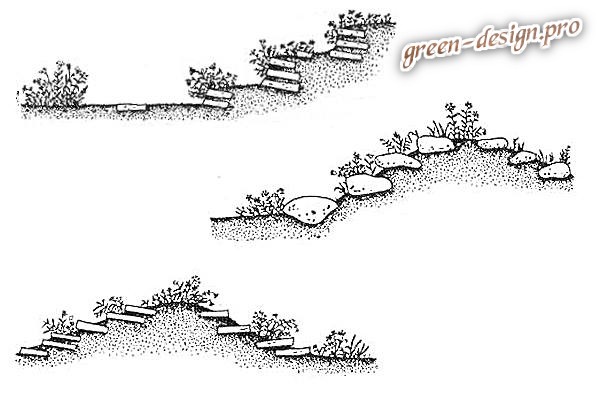
Types of alpine slides
Of course, you also need to determine the size of your composition. If you plan to install large rocks, you will most likely need to hire an excavator and other professional equipment to create optimal drainage conditions for your plants. Step 2. Collect the necessary materials Tools and materials needed to create your own alpine slide:
- Scrap for moving large stones, tape measure, cord, pegs, wheelbarrow, watering can,
- A shovel for tillage, a rake for spreading compost and a spatula for planting plantations;
- Alpine or other suitable plant species;
- Landscaping fabric or polyethylene sheet;
- Broken pots, small stones, old bricks and other fillers;
- Stones of different sizes (shale, granite or sandstone), sand, crushed stone, gravel, compost.
Step 3. Mark the boundaries of the future rock garden using rope and contrasting bulk material (sand or lime). Step 4. Remove weeds. If you cannot get rid of them in the usual way, use a herbicide to kill more resistant weeds. Step 5. Remove the soil 30 cm deep. The created "bowl" is filled with broken brick, various types of building materials waste, gravel. This will improve drainage as well as support the stones. Tamp this cushion layer well. If you are creating a slide on a flat area, fill a slide from the same material and tamp it well too.

Step 6. Separate the bottom base layer from the compost. Step 7. Place the stones.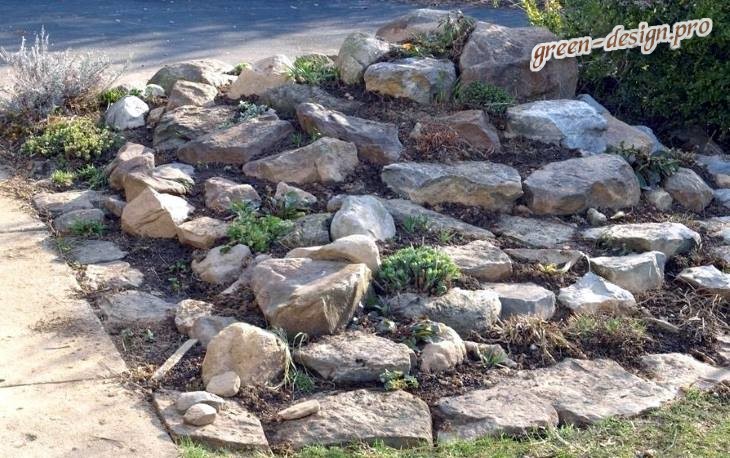
Step 8. Mix the prepared potting mix and sprinkle it around the boulders. Step 9. Take a rake and level the potting mix. Step 10. Add plants to your rock garden. Step 11. Add a layer of mulch.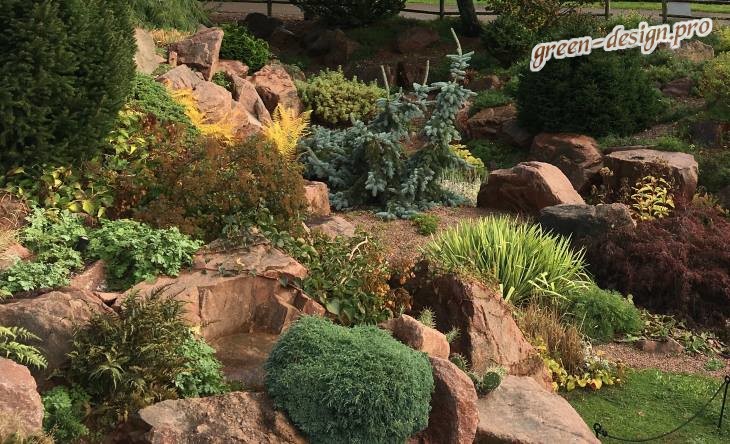
The alpine slide you have created with your own hands requires regular maintenance in the future. The rock garden as part of the garden plot is also susceptible to different kinds of pests - ants, birds, slugs, etc. You should regularly inspect your alpine slide and remove weeds. Don't over-water your plants to avoid root rot problems. Remove fallen leaves immediately. Be careful with watering to avoid root rot problems down the line.
Features of the alpine slide
The main feature is that the composition should look as natural as possible, artificial elements are not allowed.

Height
Alpine slide, as the name suggests, is a hill. The height can vary from 1 to 3 meters.









Higher compositions will require a slide core to prevent collapse. One slope should be more gentle, which is best located on the south or east side.

Stones
Also, an alpine slide is a rock garden. Depending on the type of stones, there may be more or less. Natural boulder stones of the same type, differing in size, look best.


Plants
Since the landscape composition under consideration is an imitation of a mountainous area, then plants for an alpine slide should be suitable.

It is advisable to use low-growing plants, evergreen conifers are well suited: cedar, juniper, spruce, larch.

Also suitable for use: thuja, succulents, violet, phlox, hosta and other plants.









It is best to choose flowering plants such that they bloom at different times for the beautiful appearance of the slide throughout the season.

Location
At the dacha, alpine slides on the natural slopes of the landscape or breaks look most organically. But this does not mean that such a composition cannot be created on a flat area.

Alpine slides are placed in a conspicuous place and so that the bulk of the plants are in the sun until noon, and in the afternoon in partial shade.

Not the best location in the shade of large trees and where groundwater comes close to the soil surface.

Stones: what and where to get
The basis of a slide of any type is stones and you will need a lot of them - several tons, and of different sizes. Choose from the breeds that are more common in your area. Chipped blocks look best, but already stale, with dark edges. Pellets with smooth sides can also be used, but creating a natural composition from them is not easy. You will need about one fourth of the large size, about the same as medium - the rest is small stones.
Granite looks great. But it is hard and "cold" even the most tenacious saxifrage can rarely grow on it, and the soil next to it quickly acidifies. This, too, must be borne in mind and periodically adjust the acidity (or plant plants that love acidic soil).
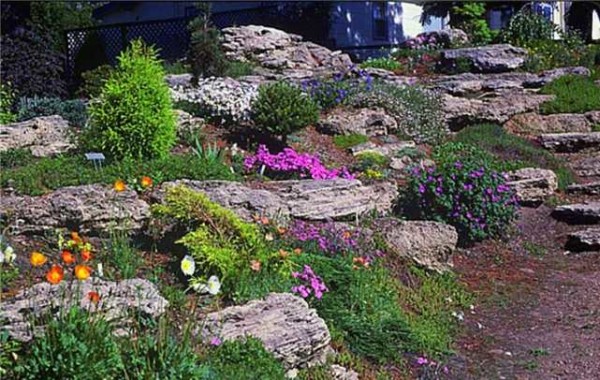
Slab stones look good on low slides
It is best to use tuff. It drains water well, water flows well through it, which is even more important - plants grow well right on it
What is more important - it neutralizes acidity, which is what the "Alpines" like.
Lime slabs are also good, but they are exactly slabs, they are good for decorating alpine plains or very low and gentle hills.
What is a rock garden
The mound of stones and plants is very similar to an alpine mountain landscape in miniature. To make the composition natural, a suitable option would be an elevation of three tiers with flower beds, with a flowing stream or a water source at the foot.
Types of alpine slides
The future design of the alpine slide depends on the type chosen. There are many options, among them:
Rocky slope. It has a rocky appearance, it is built mainly of stones, among which Alpine plants are rarely planted.
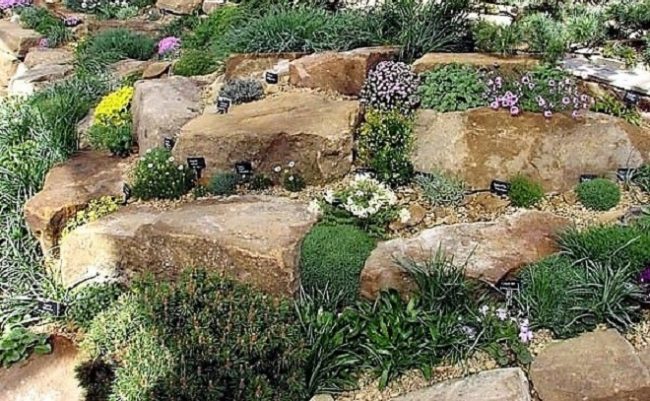 Stony slope
Stony slope
Mountain slope. This is a complex, combined composition. It uses stones of various sizes. The mountain slope is high; creeping and low-growing crops are used for its design. This building can be equipped with an artificial waterfall.
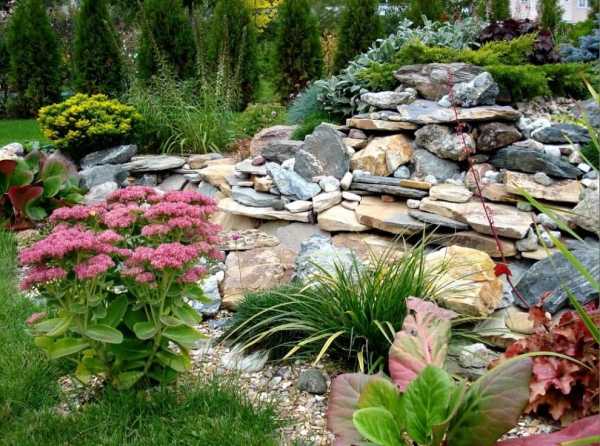 Mountain slope
Mountain slope
Terraced slope. Composition with ledges at different heights, which are lined up with retaining walls. Such structures differ in configuration and length.
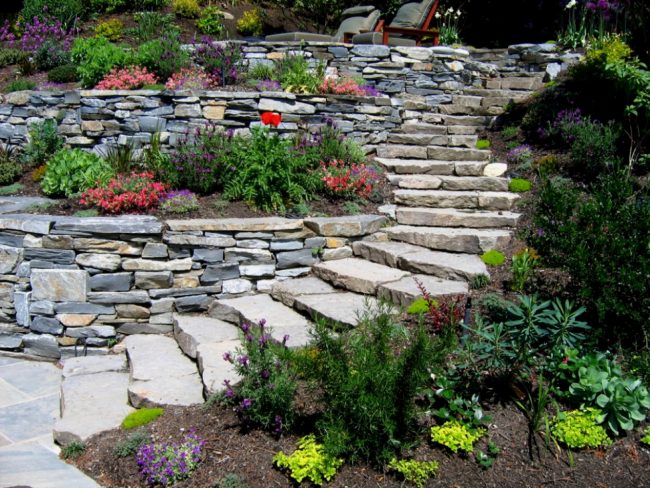 Terraced slope
Terraced slope
A hill of stones. One of the most difficult buildings to perform.The composition harmoniously combines perennial low-growing plants and large boulders.
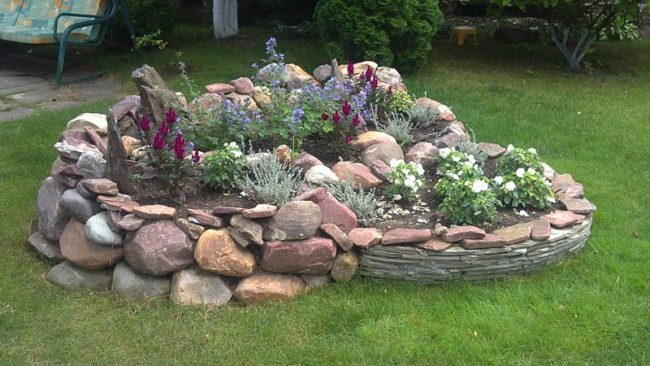 Hill of stones
Hill of stones
Mountain hollow. This is an area with stones of various sizes protruding from the ground. Boulders are diluted with plants that have a long flowering period.
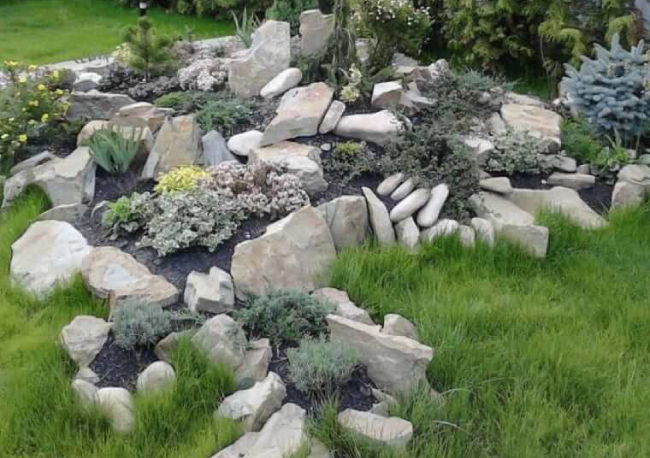 Mountain hollow
Mountain hollow
The gorge. When building, the terrain is taken into account. The slopes are formed with stones, the flora in this rock garden is represented by any ground cover plants. This composition is often built with an artificial reservoir.
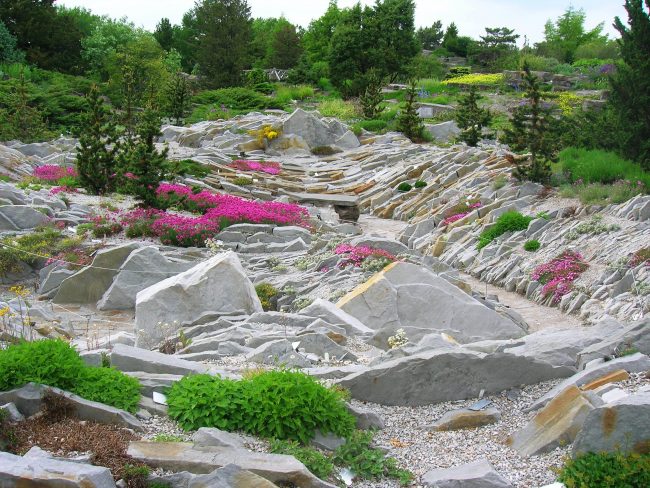 Gorge
Gorge
Czech rolling pin. A multi-tiered hill made of flat, vertically stacked stones. Alpine plants are planted near the building.
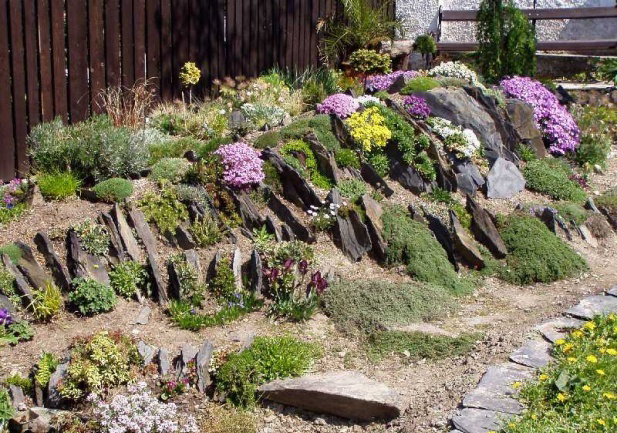 Czech rolling pin
Czech rolling pin
Valley in the mountains. It looks like a mountain hollow. It is built of large stones immersed (partially) in the soil. The composition is complemented by asymmetrically arranged plants that bloom profusely.
 Valley in the mountains
Valley in the mountains
Alpine lawn. It is a stylish mound of stones with mountainous plants. The presence of a fountain or reservoir is assumed.
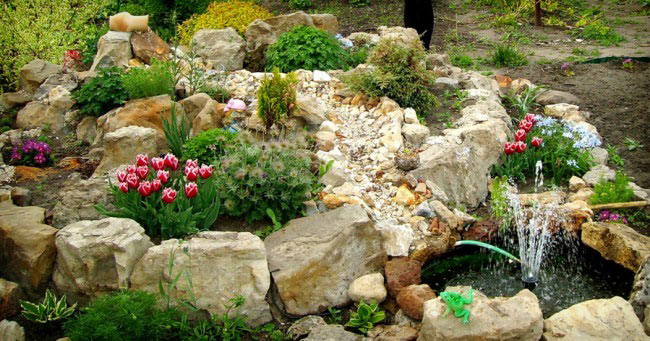
Slide stones
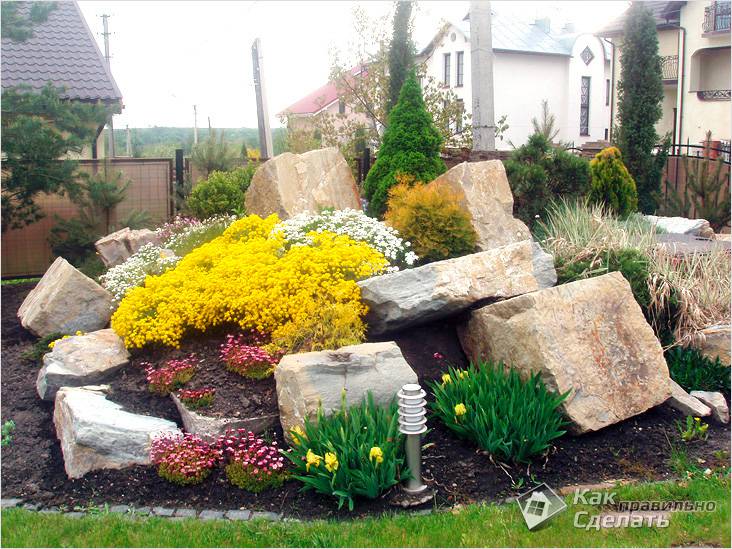 Of large stones
Of large stones
When the drain is ready, you need to pick up the stones.
- When picking up boulders, it must be borne in mind that the smaller the size of the rock garden, the smaller the size of the stones should be. For a large slide, you can take a decent size boulders, and for a small one, flagstone will come down.
- Choosing stones The only criterion that the site owner must follow when building a rock garden is the criterion of naturalness. That is, do not be too zealous. Excessive randomness in the arrangement of stones is just as unnatural as correctness.
- You shouldn't take several different kinds of boulders. Usually, in nature, heaps of stones are found from the same breed. The preference should be given to natural materials.
- For a rock garden to look really amazing, it must look good even in the absence of vegetation. This is precisely the secret of the masters.
- The slide, as a rule, has from 3 to 5-6 tiers.
- When laying stones, one must remember that soon it will be necessary to plant plants here. Therefore, a layer of moist fertile soil should be poured between the tiers. Do not stack stones too tightly.
Step-by-step instructions for creating a rock garden
There are different schemes for the device of a rock garden with your own hands. It is difficult to say which of them is better, because they are all interesting and attractive in their own way. Consider one of the instructions for creating an alpine slide using the example of the most classic and popular scheme.
Before you study the step-by-step instructions in detail, pay attention to the stages of creating an alpine slide with your own hands:
- Planning (sketching, drawing up a diagram).
- Selection of stone materials and flowers, plants.
- Site selection.
- Marking of the future structure.
- Drainage creation.
- Laying stones.
- Planting plants.
Step-by-step instructions for creating an alpine slide will help any summer resident and gardener to make a wonderful composition on their site. And now you can move on to a more detailed description.
Marking up the future structure
Ideally, you need to make a sketch of the future composition. It will help you understand how well the place is chosen, and how organically the slide will fit into the site. With the help of a sketch diagram, you need to determine how much space the structure will take, what its height will be, and also roughly calculate how much material is needed - stones, substrate, sand.
Once you have defined the shapes and boundaries of the composition, you can do the markup. The best way to do this is to use a thick rope or mark it out using lines made of some material (eg sand, crushed chalk).
Site preparation
If the soil is sandy at the place you have chosen, then the drainage base can be omitted, but in other cases, drainage is indispensable.
The creation of a drainage base includes the following steps:
- It is necessary to make a deepening in the chosen place of at least thirty centimeters (optimally 50 cm) and fill the pit with drainage material (the optimal drainage thickness is 10 centimeters, and if the soil is very dense, then the layer can be made thicker). Crushed stone, broken brick, stones of moderate parameters, gravel are ideal.
- On top of this layer, it is recommended to pour sand about 5 centimeters thick.
- After that, the material needs to be slightly compacted and covered with dug soil to the level of the rest of the earth. But before laying the soil, it is imperative to clear it of weeds.
- Then it is imperative to water this place abundantly so that the earth settles down.
The drainage layer will protect the area from moisture stagnation, provide normal air permeability in the soil. Thanks to this, plants will be able to develop and grow normally, delighting with their beauty.
Setting stones
Now you can proceed to installing the stones. The ideal shape for an alpine slide is pyramidal. Stones are laid in tiers (as a rule, from three to six tiers). That is, you need to lay stones in tiers like a pyramid to simulate a slope.
The following sequence of work should be adhered to when placing stones:
1) First, stones of the largest sizes are laid. It will be better if you bury them a little in the ground (for maximum reliability and naturalness).
2) Then the space between the installed boulders is filled with soil. As a soil, you can use a mixture of garden soil, peat, sand (mix in the same ratio).
3) After that, you need to fold the second row of stones, which is smaller in size than the first row and also fill the empty space with soil
Please note that to make the slope of the rock garden, it is necessary that each subsequent row becomes smaller than the previous one.
4) After you have set the required number of rows (and the required number is determined by your desires), you should complete the top of the composition - you can set one large or several not very large stones on the top.
Consider the classic schemes for creating an alpine slide and the location of stones:
Video: instructions on how to make an alpine slide with your own hands.
Planting
There are several excellent options for planting plants, for sure everyone can find the ideal option for their summer cottage or garden. To make a real alpine slope with your own hands, you should choose suitable plants.
Below you can study several popular schemes for planting plants on an alpine slide and choose the best option for yourself:
Classification of alpine slides for a country cottage
Admiration for the beauty and thoughtfulness of details in rock gardens is amazing. In them, each stone is in the right place, and the flowering of plants lasts all year round. Alpine slide is an aesthetic decorative element for the courtyard of a country house. There are 7 styles of its design:
- Natural rocky surface.
- “Mountain slopes” with conifers, complex curves and huge blocks of stone.
- "Valley in the mountains". This style of execution involves the chaotic placement of stones of different sizes on the territory of an alpine slide.
- “Slope with a terrace”. Different wall heights, the use of unusual shapes and elements.
- “Forest Ravine” is a decorative space with natural springs and a waterfall. It can be created artificially.
- “Wall of stone”. Here the stones are arranged in a chaotic manner, and the mound has a small height.
- "Rock from the Czech Republic". The masonry in it is made in layers of stones of the same size.
- "Lawn in the Alps". It is a combination of wild mountain plants and conifers. All of them germinate exclusively in the mountains, therefore, special conditions should be created for their optimal growth and development.
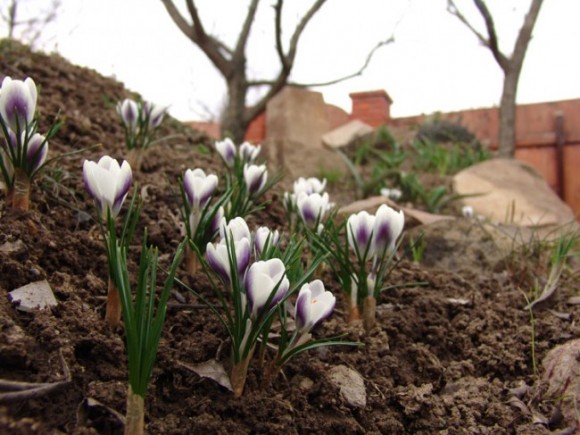
Create a rock garden base in the fall to plant seeds of plants and tree seedlings in the spring in the spring.Already in the summer you will enjoy the aesthetic beauty of the created composition.


